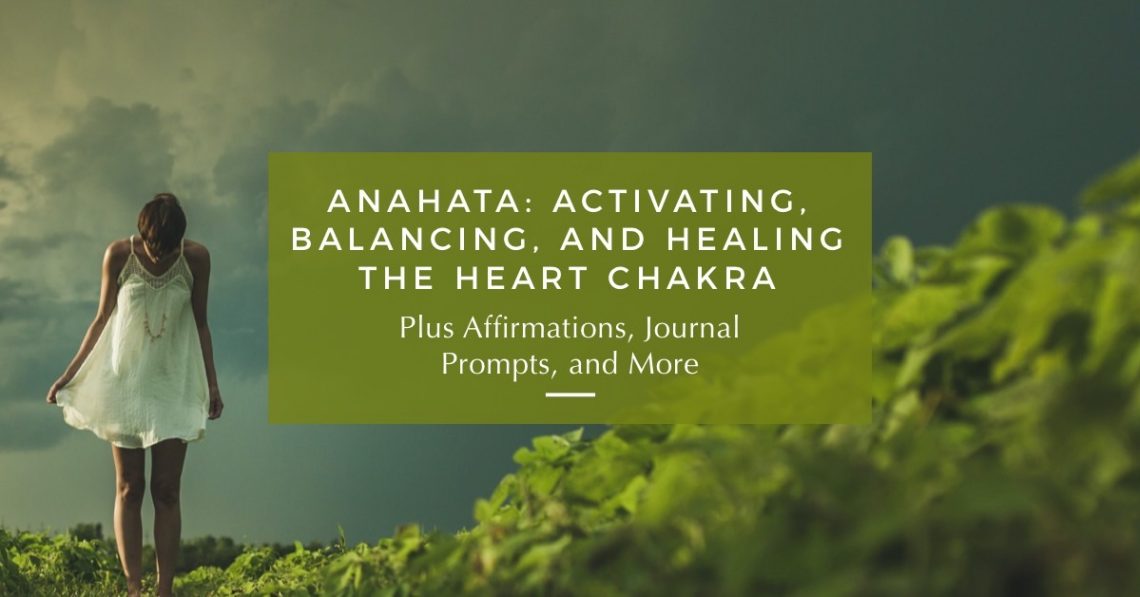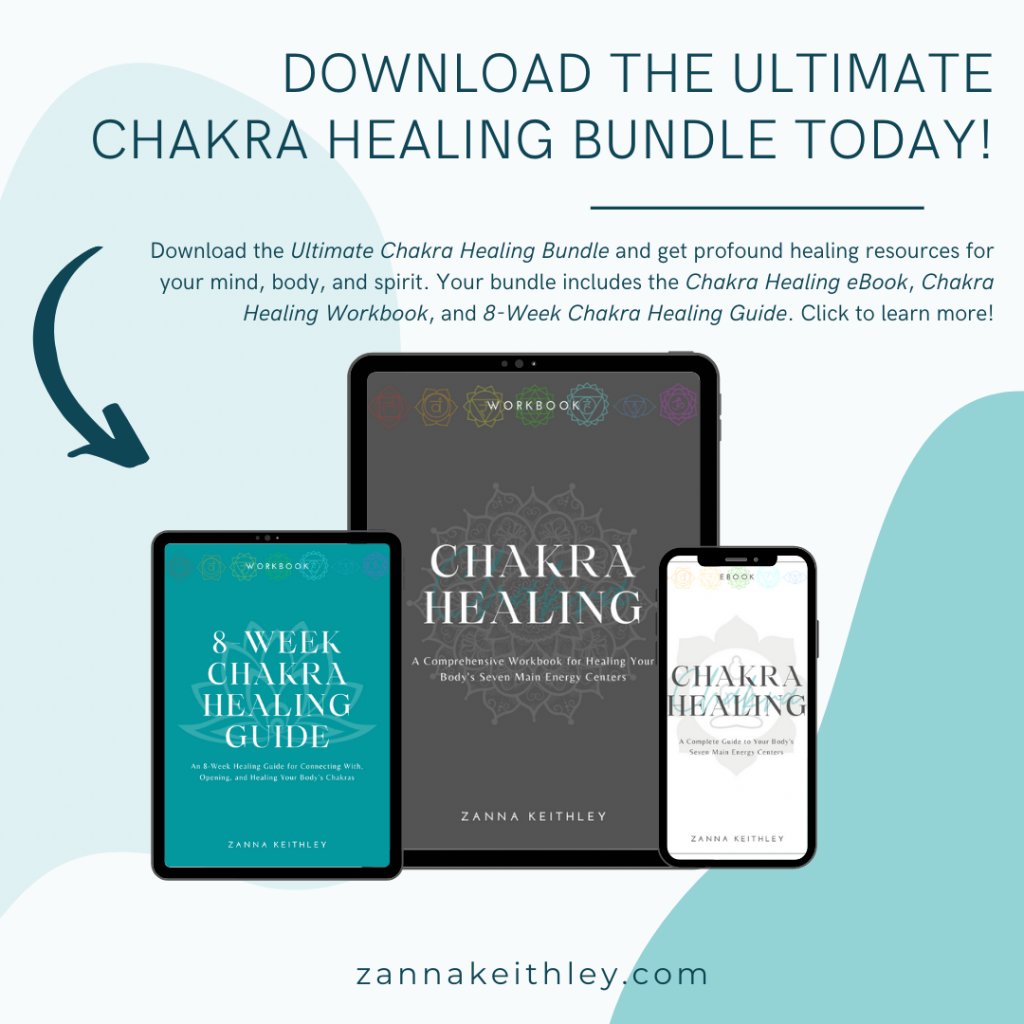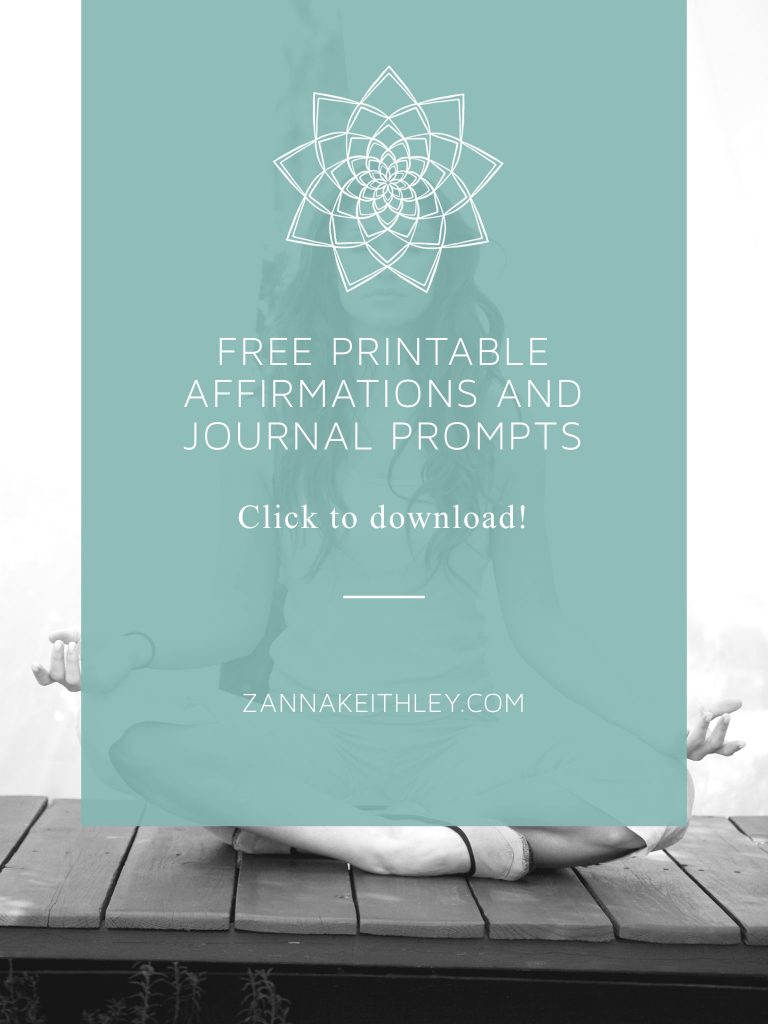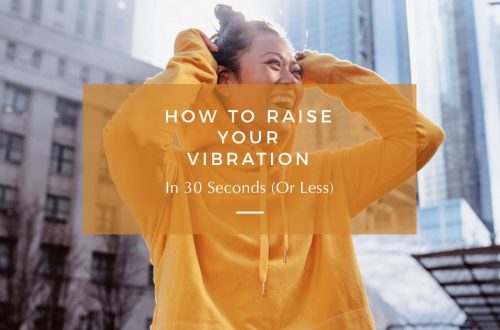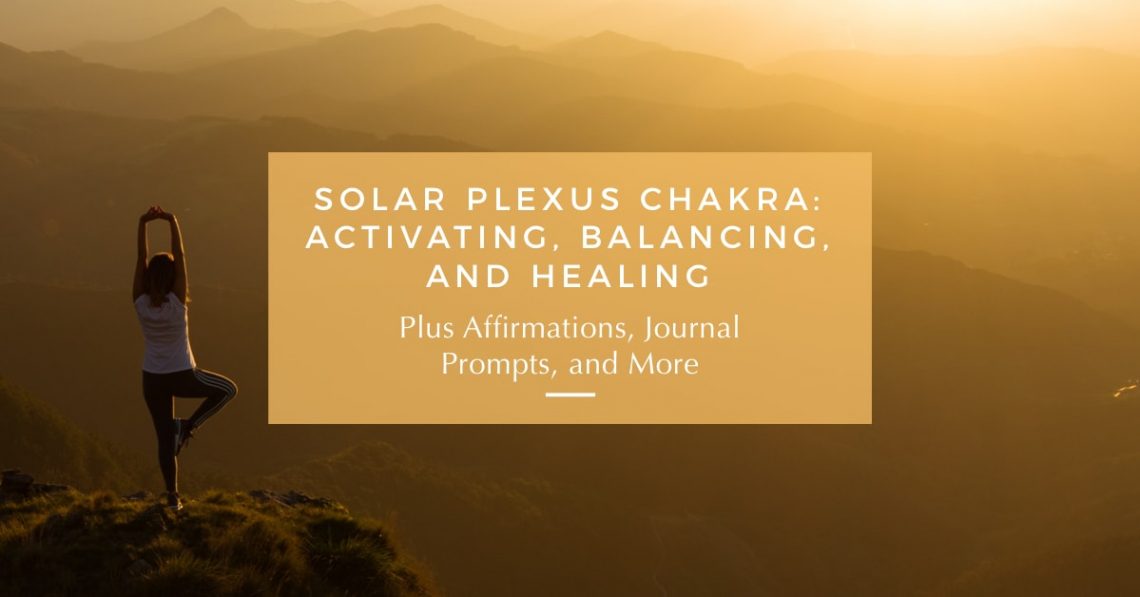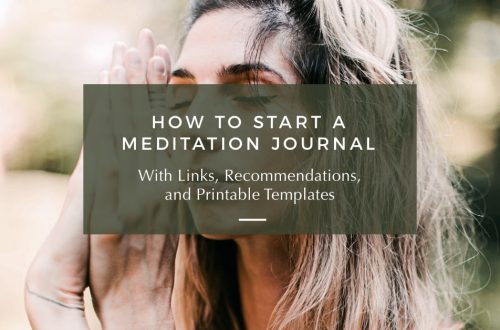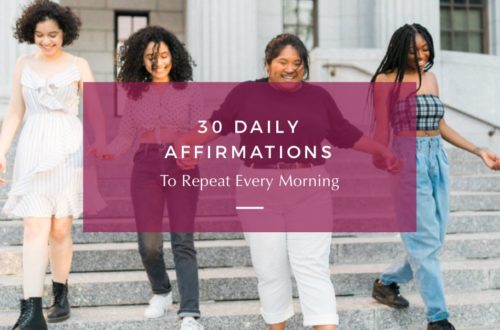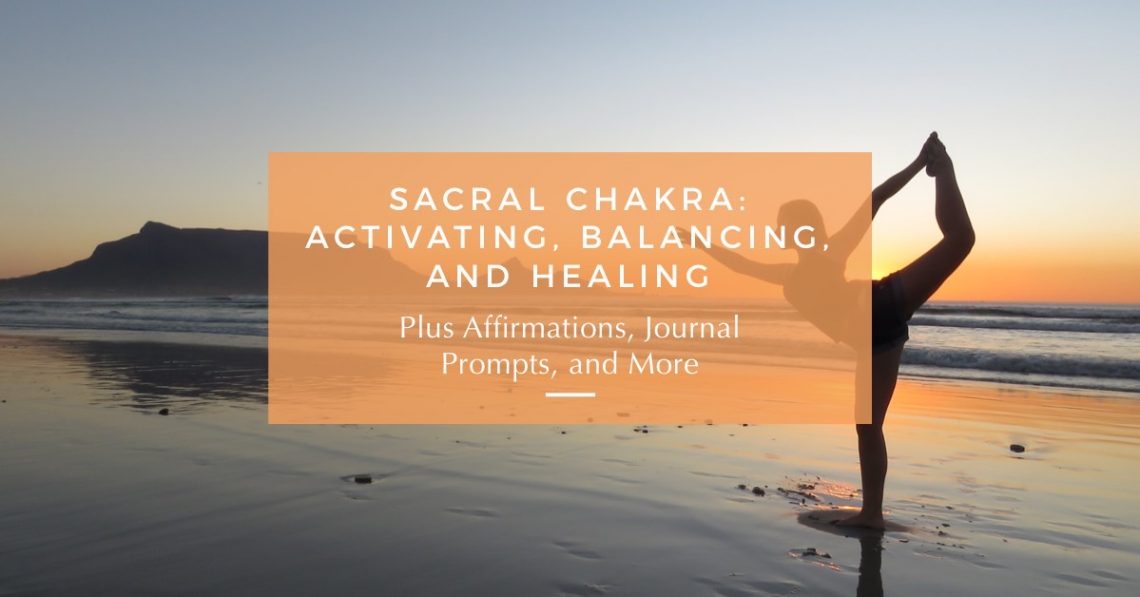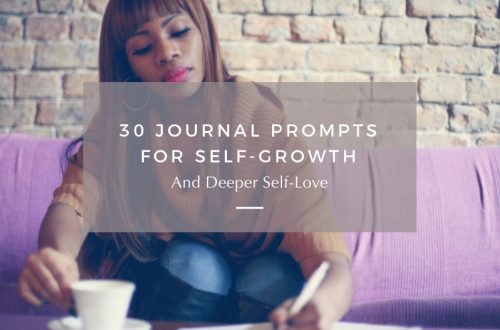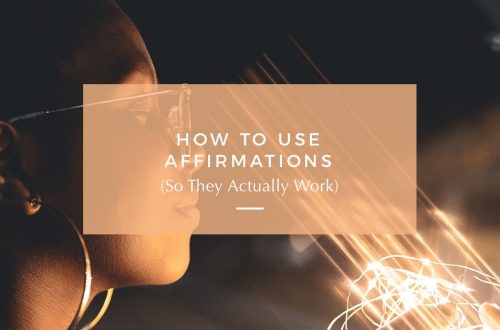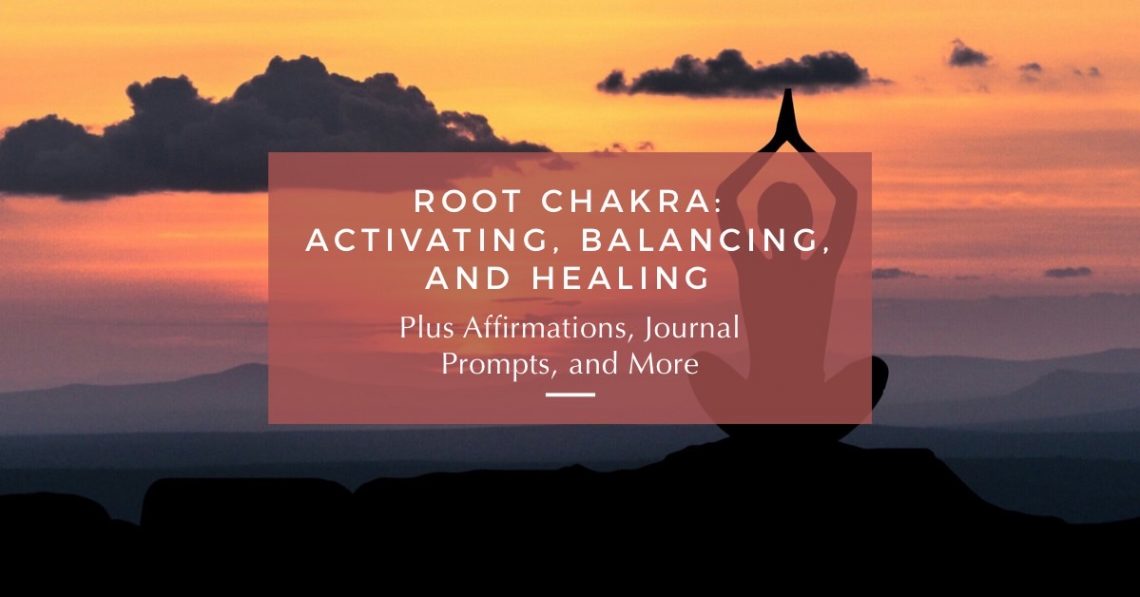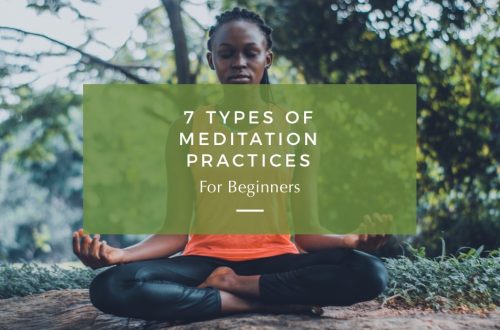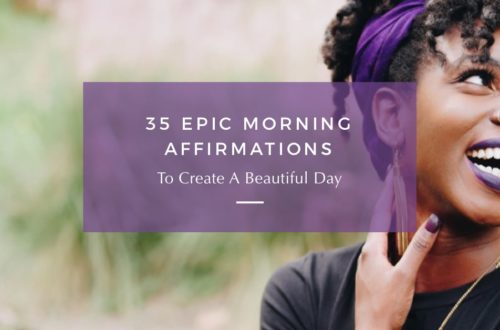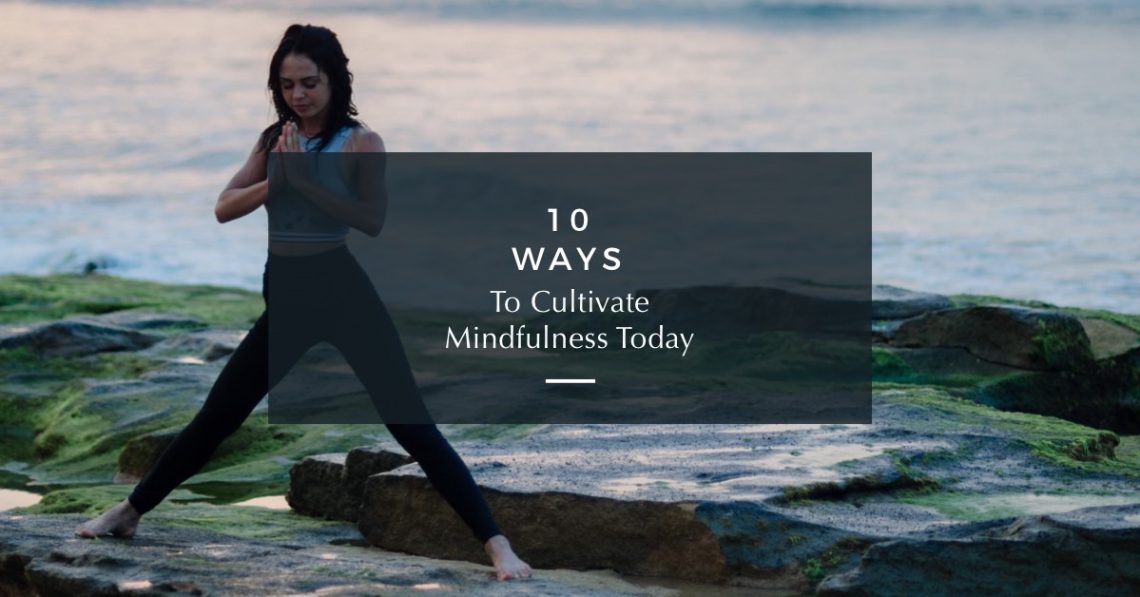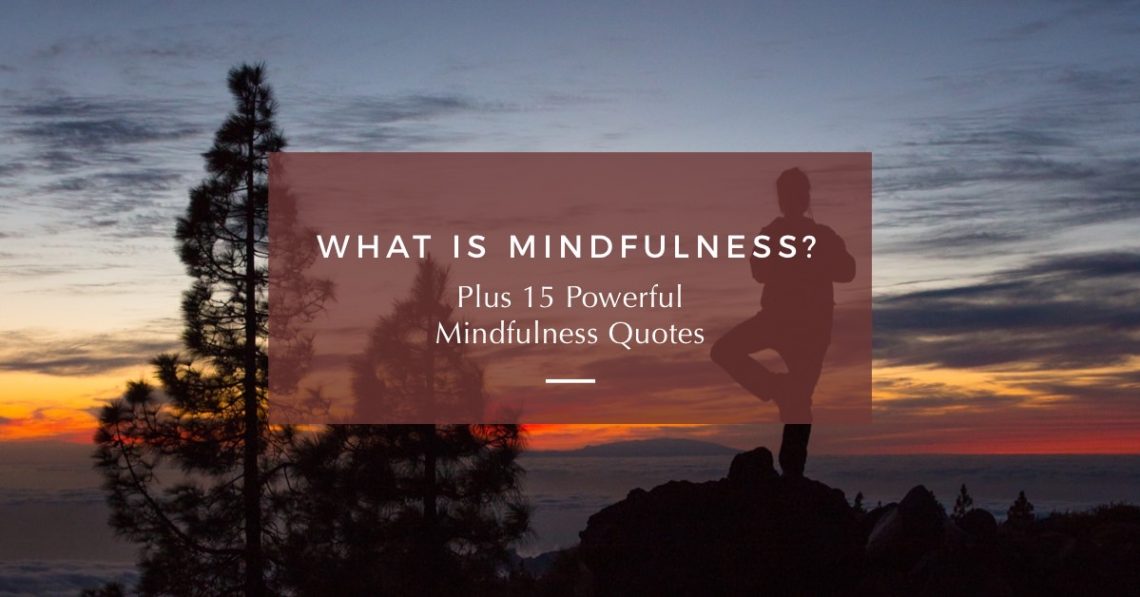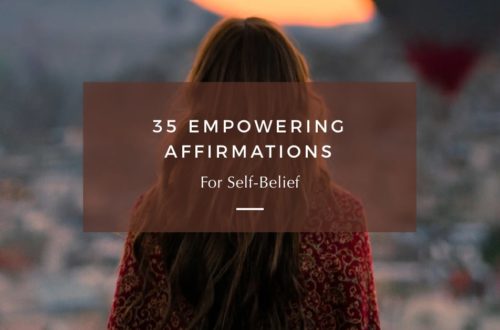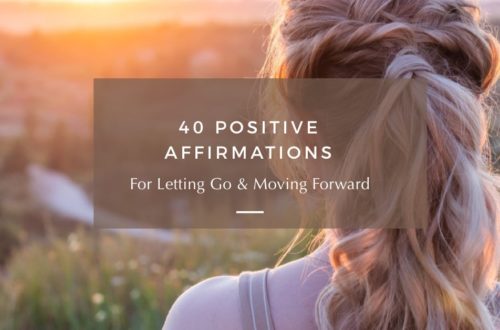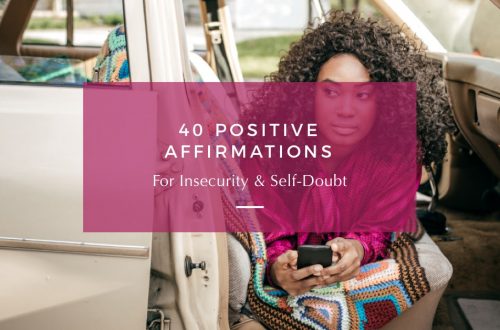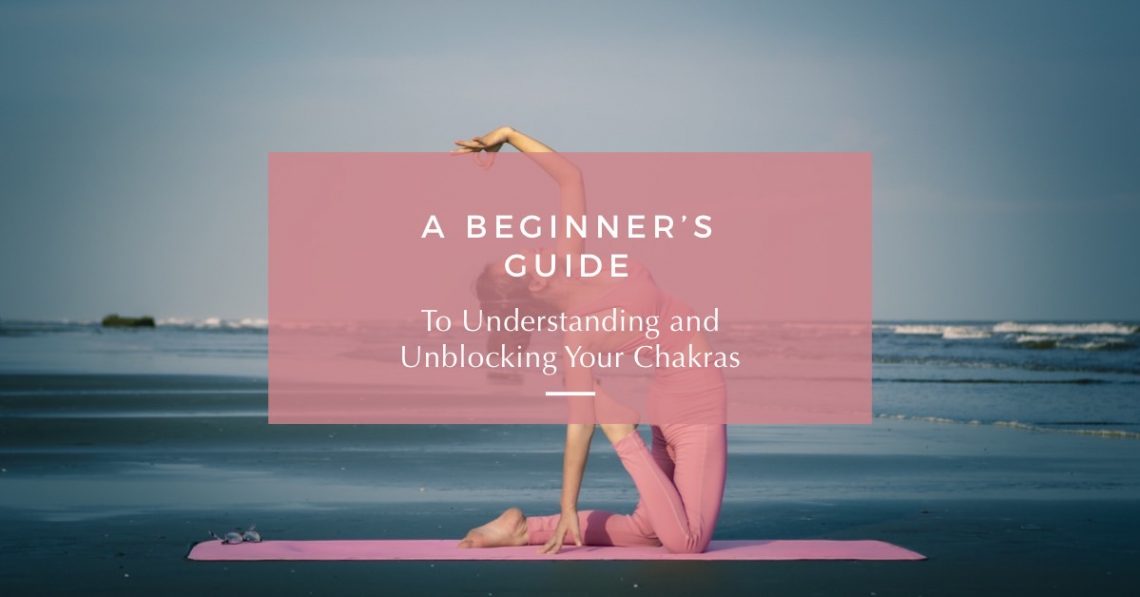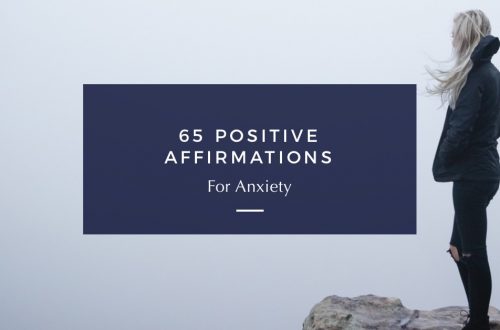-
Anahata: Healing the Heart Chakra
Want to learn more about Anahata, also known as your heart chakra? Discover how to heal, balance, and restore harmony to the energy center of love and compassion. Plus, don’t miss the heart-centered affirmations and journal prompts dedicated to aligning you with your pure, loving energy within. And be sure to check out the links to learn more about chakras below!
Also, be sure to scroll to the bottom of this page for some awesome freebies! You’ll receive 40 free printable affirmations and 30 journal prompts to open and heal the heart chakra. Don’t miss these powerful healing tools!
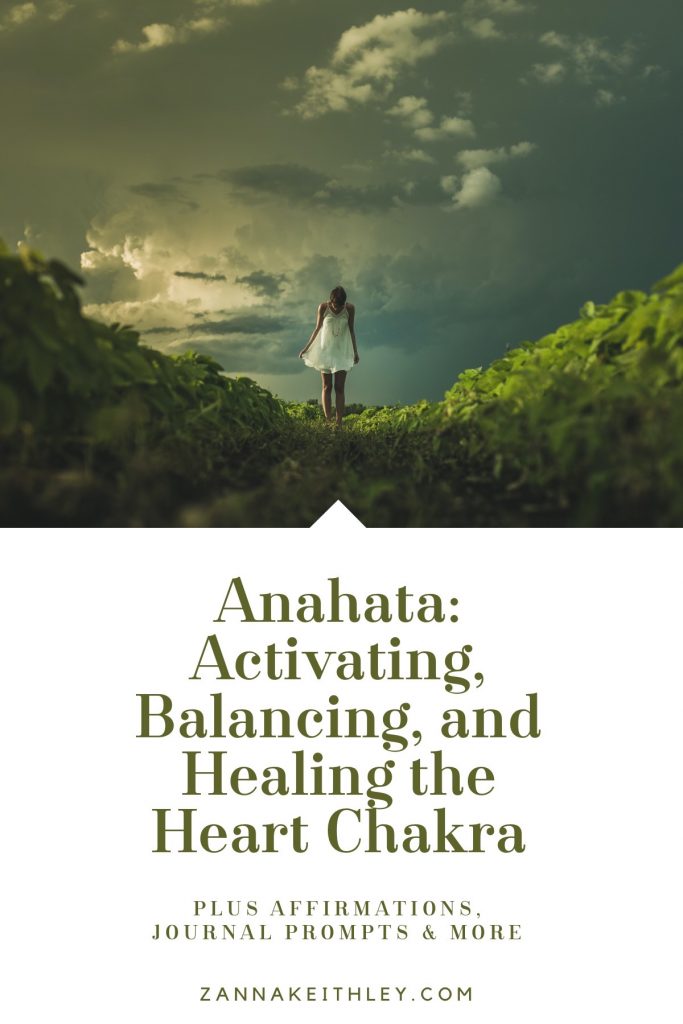
Pin this for later! Anahata: Activating, Balancing, and Healing the Heart Chakra Discover More About Chakras
Discover more about chakras using the links below, plus get journal prompts and affirmations for each of your body’s main energy centers! And for deeper insight into chakras as well as guidance on profound chakra healing, check out my Ultimate Chakra Healing Bundle, which includes a Chakra Healing eBook, Chakra Healing Workbook, and 8-Week Chakra Healing Guide. You can also discover more in my online shop.
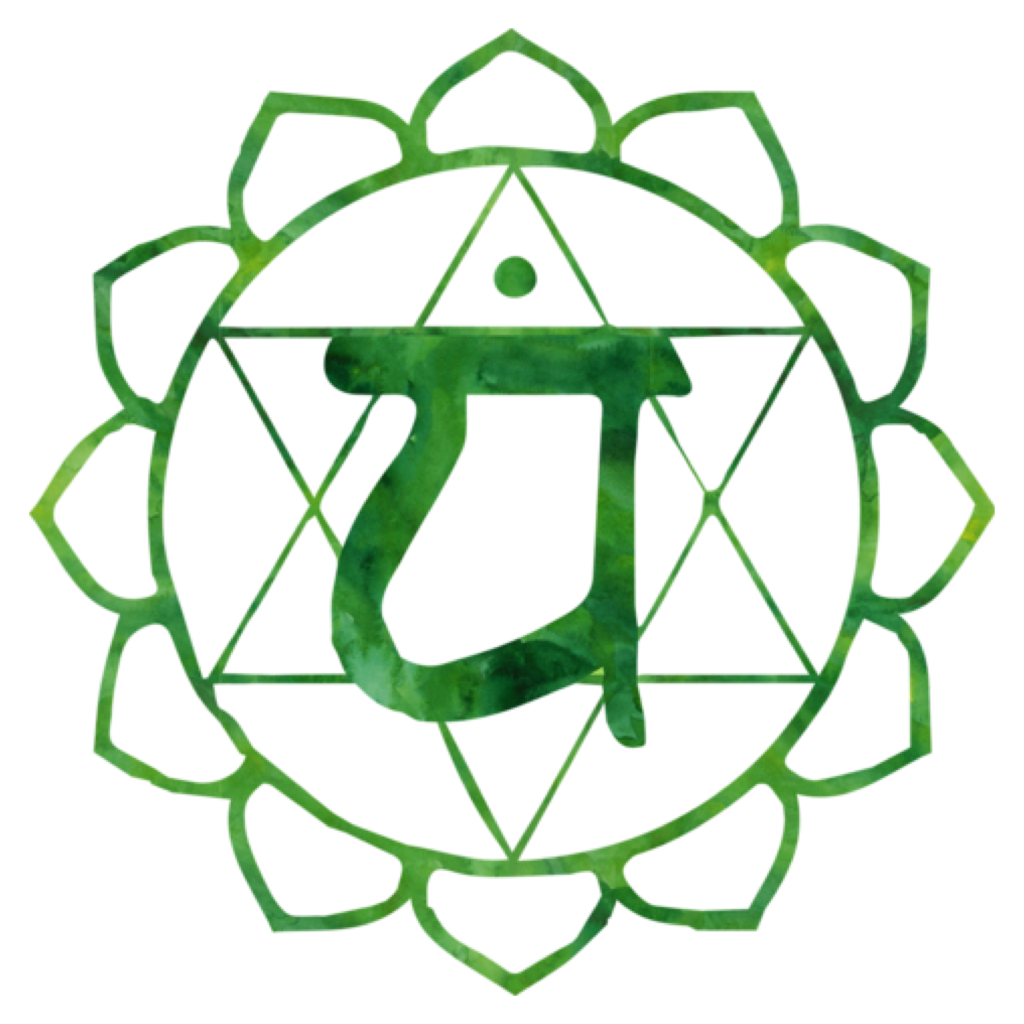
Introduction to Anahata: The Heart Chakra
Chances are, even if you know nothing about chakras, you at least have some understanding of the heart chakra and its primary emotions and attributes.
Your heart chakra, or Anahata, is the energy center for love, compassion, peace, and connection. The love you cultivate within your heart chakra is deep, pure, and unconditional. And this love extends throughout your whole self and beyond.
This love means having unconditional love for yourself, no matter where you are in life, and having deep compassion for your imperfections and mistakes. This love means knowing you are worthy of love, kindness, and understanding no matter what.
And this love also extends far beyond yourself. When your heart chakra is balanced, you feel a deep sense of connection with others. In fact, this connection may feel so deep, you know that you’re not truly separate from anyone else.
Instead, you know and feel that you are connected to all.
Why Balancing the Heart Chakra is Important
The primary emotions associated with the heart chakra – love and compassion – may not be super surprising. In fact, what may be the most surprising discovery about the heart chakra is that its primary color is green, not pink or red.
But when you think about it, the color green is kind of perfect for this energy center.
Green is the color of harmony and balance. It symbolizes nature and life. It is the color of renewal and growth. Of perfect harmony and perfect health.
And that’s what love is, too. Love is harmony. Love is renewal. Love is our foundation. Love is life.
So you can see why keeping the heart chakra in balance is important.
When the energy in our heart center flows freely in and out, we are in alignment with our highest, truest, most authentic selves. We know that love is more than just a feeling; it is our very essence. We are kinder, more compassionate, more understanding, and more forgiving. We love ourselves enough to know our inherent worthiness, and we love others enough to know that we are connected to all.
Love is not weakness. Love is not sacrifice. Love is not an afterthought.
Love is strength. Love is your foundation. Love is your superpower.
Heart Chakra Attributes
- Sanskrit Name: Anahata (“Unstruck”)
- Location: Heart/Center of chest
- Color: Green
- Body Parts: Heart, Lungs, Shoulders, Arms, Ribs, Breasts, Diaphragm
- Symbol: Twelve-petaled lotus with two intersecting triangles in the center
- Element: Air
- Mantra: YAM
- Gemstones: Rose Quartz, Jade, Green Calcite, Emerald, Rhodonite, Pink Opal
- Essential Oils: Lavender, Rose, Jasmine, Geranium, Goldenrod, Cypress
Signs of a Balanced Heart Chakra
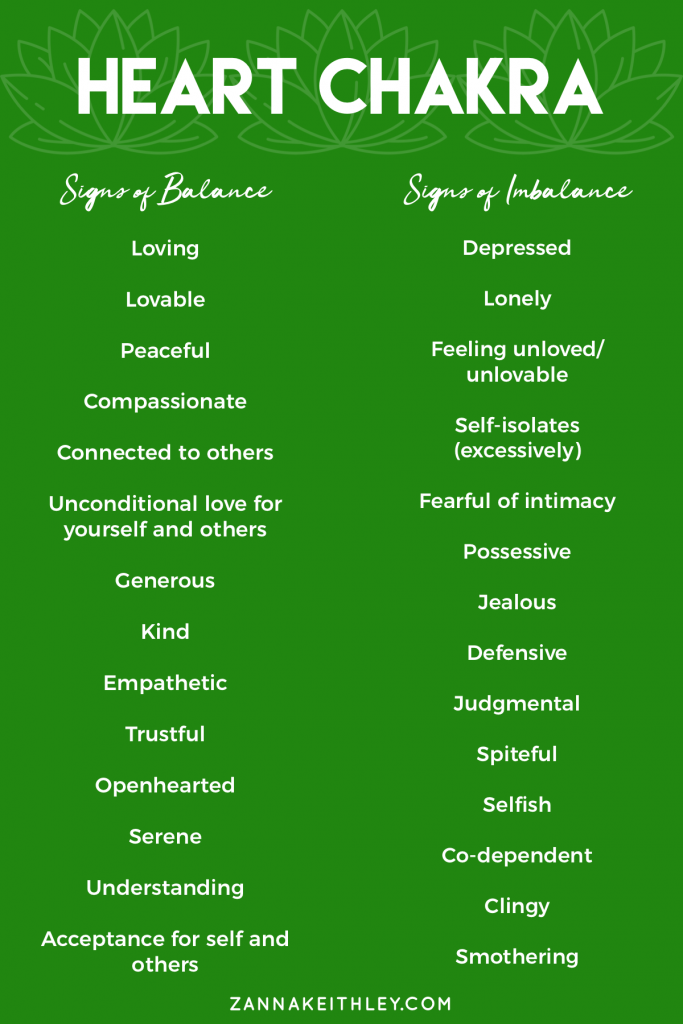
As you might be able to guess, love is at the center of a balanced heart chakra. When this energy center is balanced, our thoughts and actions are aligned with the highest frequency of pure and unconditional love.
When the energy in your heart chakra is flowing freely, you feel loved, loving, and lovable. Your heart is open, and you feel a strong sense of connection to others. As mentioned in the intro, you may even feel like there is no separateness; you are one with all.
Here are some of the signs of a balanced heart chakra:
- Loving
- Lovable
- Peaceful
- Compassionate
- Connected to others
- Generous
- Kind
- Empathetic
- Trustful
- Openhearted
- Serene
- Understanding
- Acceptance for self and others
- Unconditional love for self and others
Signs of an Imbalanced Heart Chakra
Imbalances in the chakras mean they can become either overactive or underactive. While a balanced heart chakra means you feel connected to others and enjoy the presence of others, an overactive heart chakra means you may become a little too attached to the presence of others, sometimes becoming clingy and dependent on one or more people. On the other end, if your heart chakra is underactive, you may excessively self-isolate and feel fearful of intimacy.
Here is a list of signs that your heart chakra may be imbalanced:
- Depressed
- Lonely
- Feeling unloved/unlovable
- Self-isolates (excessively)
- Fearful of intimacy
- Possessive
- Jealous
- Defensive
- Judgmental
- Spiteful
- Selfish
- Co-dependent
- Clingy
- Smothering
Physical Signs of an Imbalanced Heart Chakra
In addition to experiencing emotional, physical, and spiritual ailments due to energy imbalances, you may also experience physical symptoms. With an imbalanced heart chakra, many of the physical symptoms you may experience correlate to the chest, areas around your chest, and your blood and circulatory system.
Here’s a list of the physical ailments you may experience with an imbalanced heart chakra:
- Heart Disorders
- High/Low Blood Pressure
- Circulatory Problems
- Asthma
- Chest Pain
- Muscle Tension
Heart Chakra Affirmations
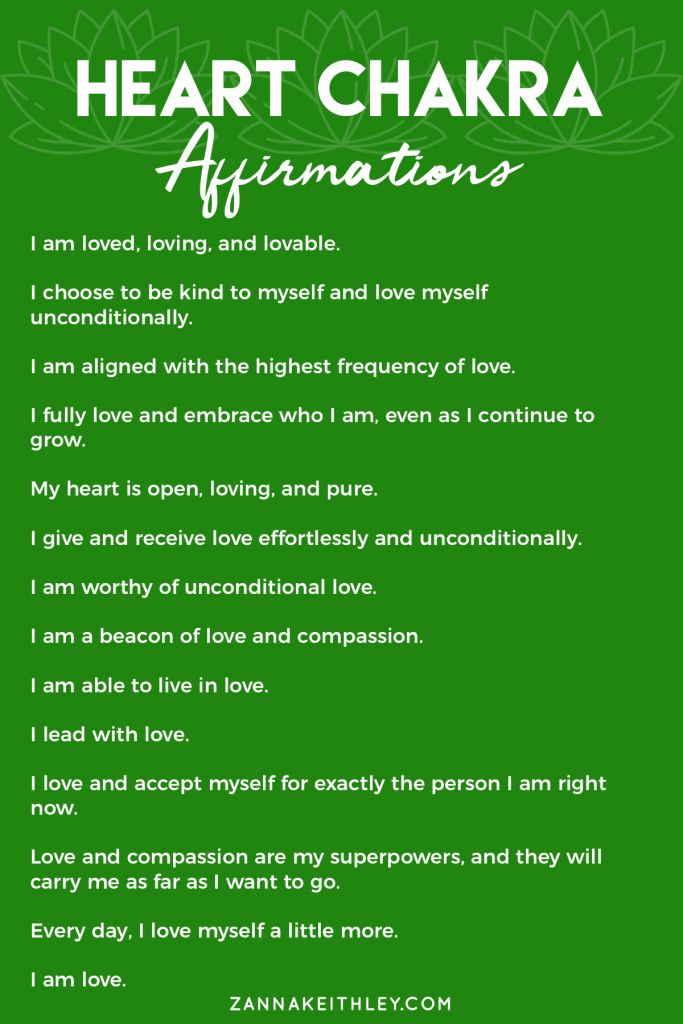
Affirmations are positive, present-tense statements that uplift, encourage, boost your self-belief, and support your total wellbeing. I love using affirmations not only to help with balancing and healing my chakras but as part of a complete self-care routine.
When using affirmations to balance and heal your chakra, really focus on the feelings of love, belonging, acceptance, peace, and compassion. Go beyond just reciting the words and allow yourself to really feel the positive feelings that your affirmations bring.
Here’s a list of beautiful, empowering affirmations for your heart chakra:
- I am loved, loving, and lovable.
- I choose to be kind to myself and love myself unconditionally.
- I am aligned with the highest frequency of love.
- I fully love and embrace who I am, even as I continue to grow.
- My heart is open, loving, and pure.
- I give and receive love effortlessly and unconditionally.
- I am worthy of unconditional love.
- I am a beacon of love and compassion.
- I am able to live in love.
- I lead with love.
- I love and accept myself for exactly the person I am right now.
- Love and compassion are my superpowers, and they will carry me as far as I want to go.
- Every day, I love myself a little more.
- I am love.
For more powerful heart chakra affirmations, check out my post, 40 Heart Chakra Affirmations for Unconditional Love. And be sure to scroll to the bottom of this page to get your free printable affirmations and journal prompts!
Heart Chakra Journal Prompts
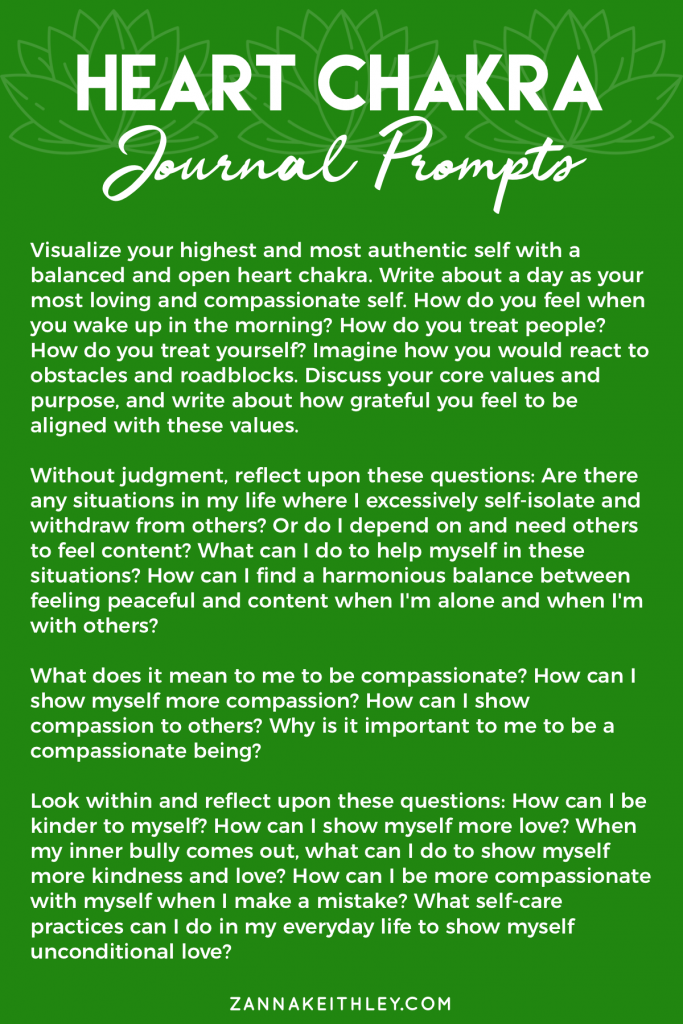
Like affirmations, journaling is another powerful practice that supports your total wellbeing. I like to journal for thirty minutes first thing after I wake up to set a positive tone for the day (with a freshly brewed, hot cup of coffee, of course). However, I know a lot of other people like to journal in the evening to help them leave work behind and unwind for the night. There is no right or wrong place or time; the key is to find a time that works for you.
The journal prompts below are designed to help you get in touch with your heart chakra. I’m not a big fan of rules when it comes to creativity and self-care activities, so if you find yourself straying from the prompts at all, that’s okay! Your writing may take you to unexpected places, like a distant memory or a vision of the future. For the purposes of balancing your heart chakra, just remember to stay heart-centered and hold the intention of healing, activating, or even just getting to know your heart chakra a little better.
- Visualize your highest and most authentic self with a balanced and open heart chakra. Write about a day as your most loving and compassionate self. How do you feel when you wake up in the morning? How do you treat people? How do you treat yourself? Imagine how you would react to obstacles and roadblocks. Discuss your core values and purpose, and write about how grateful you feel to be aligned with these values.
- Without judgment, reflect upon these questions: Are there any situations in my life where I excessively self-isolate and withdraw from others? Or do I depend on and need others to feel content? What can I do to help myself in these situations? How can I find a harmonious balance between feeling peaceful and content when I’m alone and when I’m with others?
- What does it mean to me to be compassionate? How can I show myself more compassion? How can I show compassion to others? Why is it important to me to be a compassionate being?
- Look within and reflect upon these questions: How can I be kinder to myself? How can I show myself more love? When my inner bully comes out, what can I do to show myself more kindness and love? How can I be more compassionate with myself when I make a mistake? What self-care practices can I do in my everyday life to show myself unconditional love?
For more heart chakra journal prompts, check out my post, 30 Journal Prompts to Open and Heal the Heart Chakra.
Activating and Healing the Heart Chakra (Anahata)
Color Therapy
Immerse yourself in the color green. Eat green foods, such as broccoli, spinach, green apples, and kiwi. Drink some tasty matcha. Write heart-centered affirmations on green post-it notes and stick them up around you. Wear green. Write with a green pen. Paint with the color green. Hang or sit some green objects around your workspace.
Walk in Nature
The color of the heart chakra is green, and its element is air. Combine these attributes by taking a long, cleansing walk in nature, breathing in the fresh air. If you live near a forest or a beautiful, green meadow, this is ideal, but just taking a walk and getting some fresh air can do wonders for healing your heart chakra. You might also go to the beach on a breezy day and let the cool wind dance across your skin.
Drive with the Windows Down
This may not heal your heart chakra on its own, but if you’re out driving and it’s a nice day out, lower your windows and embrace the feeling of the air blowing across your skin.
Journaling
You can use the journal prompts above or simply write about what’s going on in your heart. How does your heart feel? How can you open yourself up to more love in your life? What past wounds still need to be healed? I also love incorporating affirmations into my journaling. When working with the heart chakra, there’s absolutely nothing wrong with simply writing an empowering, soul-healing list of heart-centered affirmations in your journal. (In fact, this is 100% right.)
Yoga
Yoga is a beautiful way to restore harmony and balance among your energy centers. To heal the heart chakra, focus on heart-opening positions.
Here are a few positions that help with healing the heart chakra:
- Camel Pose
- Wheel Pose
- Handstand
- Fish Pose
- Extended Puppy Pose
- Bridge Pose
- Cow Face Pose
For more, check out this video from Yoga With Adriene: Heart Chakra Yoga for Beginners.
Meditation
Visualize a beautiful green light at your heart center. See that light growing brighter as you inhale and bigger as you exhale. You can also visualize a green rosebud at the center of your chest. As you inhale and exhale, the buds slowly unfolds and bloom.
And if you prefer guided meditations, or just want to give it a try, here are some free guided meditations for the heart chakra on the Insight Timer app:
- Heart Chakra Activation by Niajae Wallace
- Anahata – Help to Balance the Heart Chakra by Scott Hutchison-McDade
- Heart Chakra – Heal, Open, & Align by Naomi Goodlet
- Heart Chakra Opening by Ola Radka
Anahata Affirmations
You can use the affirmations above or come up with your own heart-centered affirmations. When you use affirmations for your heart chakra, focus on feelings and beliefs that are rooted in love, compassion, understanding, peace, kindness, and connection – both for yourself and others. You can choose to recite your affirmations in your head or out loud, or you can write them down in a journal or a notebook. No matter what method you choose, open yourself up to feelings of love. Know that you are worthy and deserving of being loved, and know that it is safe for you to show love. You might even place your hands out in front of you, palms to the sky, and gently repeat, “I allow love. I accept love. I receive love.”
Anahata Gemstones
Crystals support and promote balance and harmony within your energy centers. When working with your heart chakra, crystals help with healing past hurts, restoring your belief in love, and opening your heart again to love and trust.
One of my favorite methods of using crystals is through meditation. You can hold the crystal while meditating, or when balancing the heart chakra, you can lay down and set the crystal on your heart center. I also love wearing crystals as jewelry. Wearing an emerald necklace near your heart is a beautiful way to support balance and healing.
Here are a few gemstones associated with the heart chakra:
- Rose Quartz
- Jade
- Green Calcite
- Emerald
- Rhodonite
- Pink Opal
To learn more about cleansing, programming, and using crystals, check out my blog post about crystals here!
Anahata Essential Oils
Using essential oils is a really wonderful practice for balancing the chakras for so many reasons: they smell good, there are so many ways to use them, and you can incorporate essential oils with most of the other practices on this list. For instance, you can use any of the essential oils below in your diffuser while journaling or as you’re meditating. Just make sure to set aside some dedicated time for yourself, and set the intention to heal, balance, and restore harmony to your energy centers.
Below are just some of the essential oils you could use to balance the heart chakra. Also, be sure to check out what each individual brand offers, as some have lines specifically for the chakras!
- Lavender
- Rose
- Jasmine
- Geranium
- Goldenrod
- Cypress
- Bergamot
Are you ready for your freebies? Download your free heart chakra printables below!
For more chakra resources, positive affirmations, self-love tools, and more, be sure to follow me on Pinterest and Instagram!

Pin this for later! Anahata: Activating, Balancing, and Healing the Heart Chakra 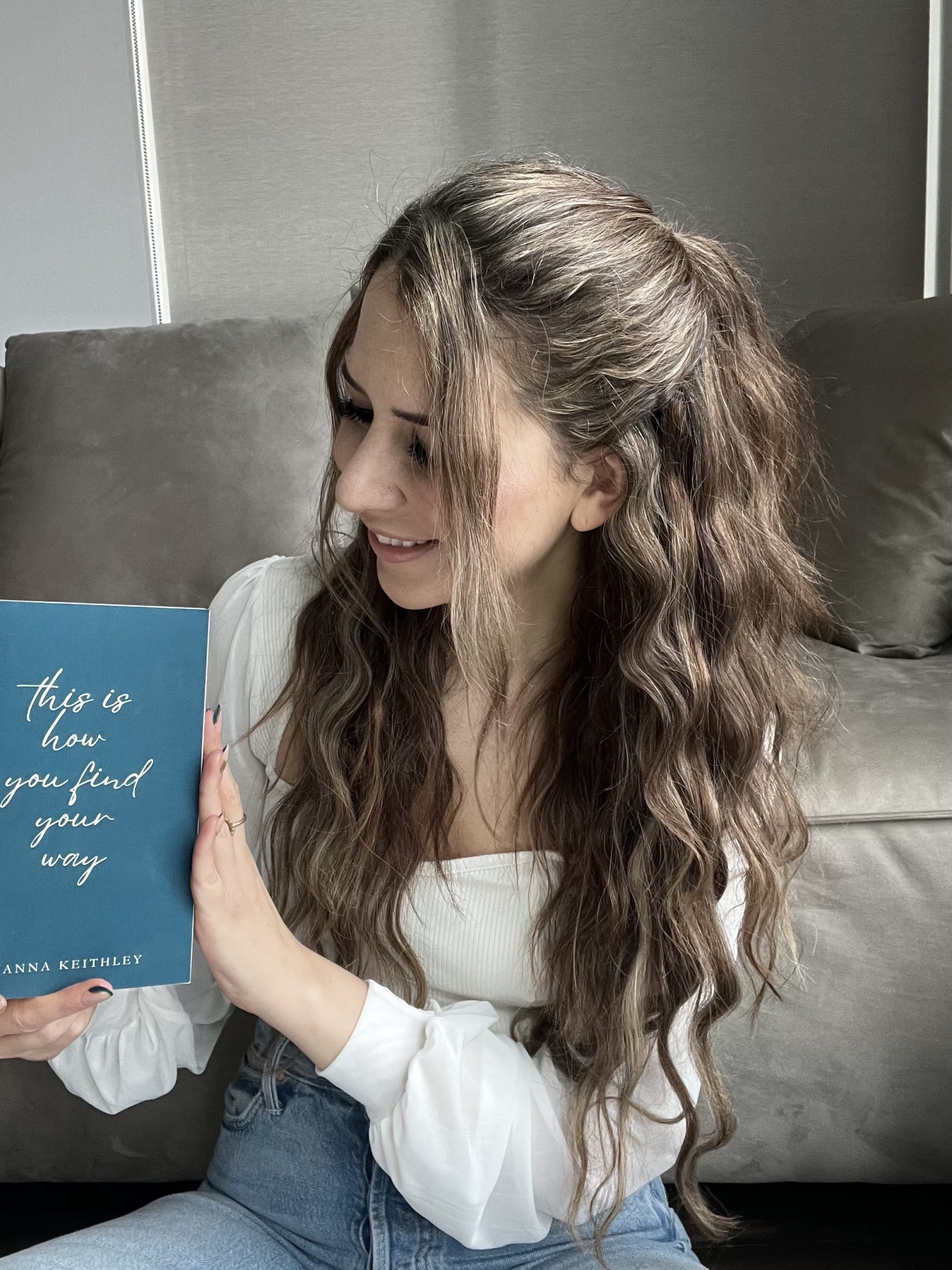
Zanna Keithley is an author, poet, and social media content creator who writes short prose dedicated to inspiring readers to follow their dreams, trust their intuition, and create beautiful and fulfilling lives. You can find her original writing on Instagram @zannakeithley.
-
What is the Solar Plexus Chakra?
What is the solar plexus chakra? Today’s post is going to answer that question and give you everything you need to know about this powerful energy center, including signs of imbalance, affirmations, journal prompts, and methods to balance and heal. For a refresher on chakras, be sure to check out A Beginner’s Guide to Understanding and Unblocking Your Chakras.
Also, be sure to scroll to the bottom of this page for some awesome freebies! You’ll receive 35 free printable affirmations and 30 journal prompts to open and heal the solar plexus chakra. Don’t miss these powerful healing tools!
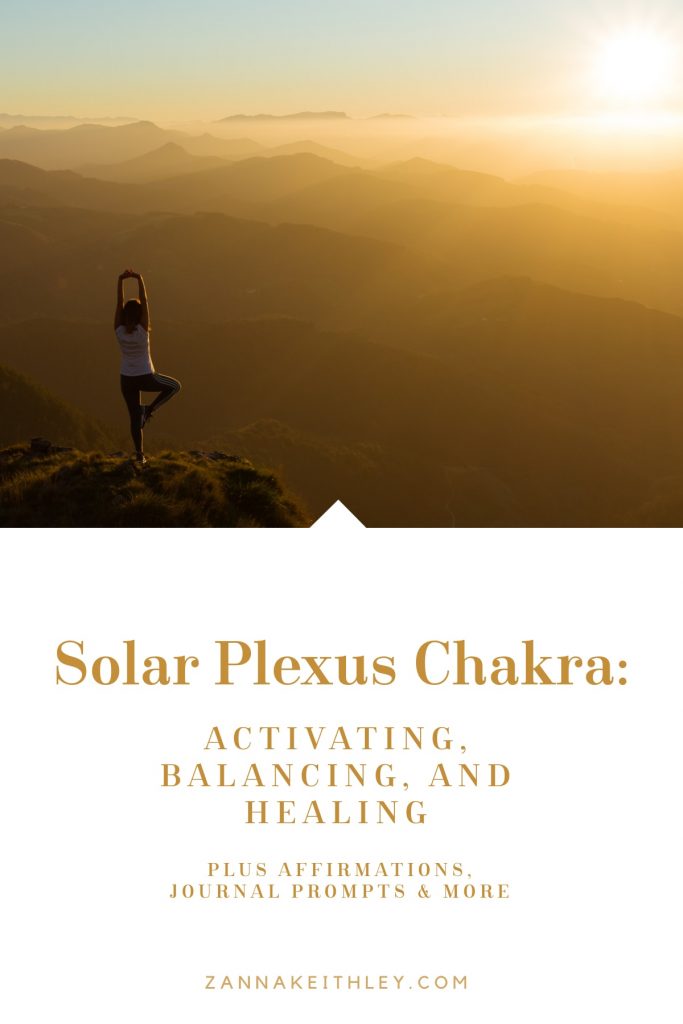
Pin this for later! What is the Solar Plexus Chakra? Activate, Balance, & Heal Discover More About Chakras
Discover more about chakras using the links below, plus get journal prompts and affirmations for each of your body’s main energy centers! And for deeper insight into chakras as well as guidance on profound chakra healing, check out my Ultimate Chakra Healing Bundle, which includes a Chakra Healing eBook, Chakra Healing Workbook, and 8-Week Chakra Healing Guide. You can also discover more in my online shop.
Introduction to the Solar Plexus Chakra
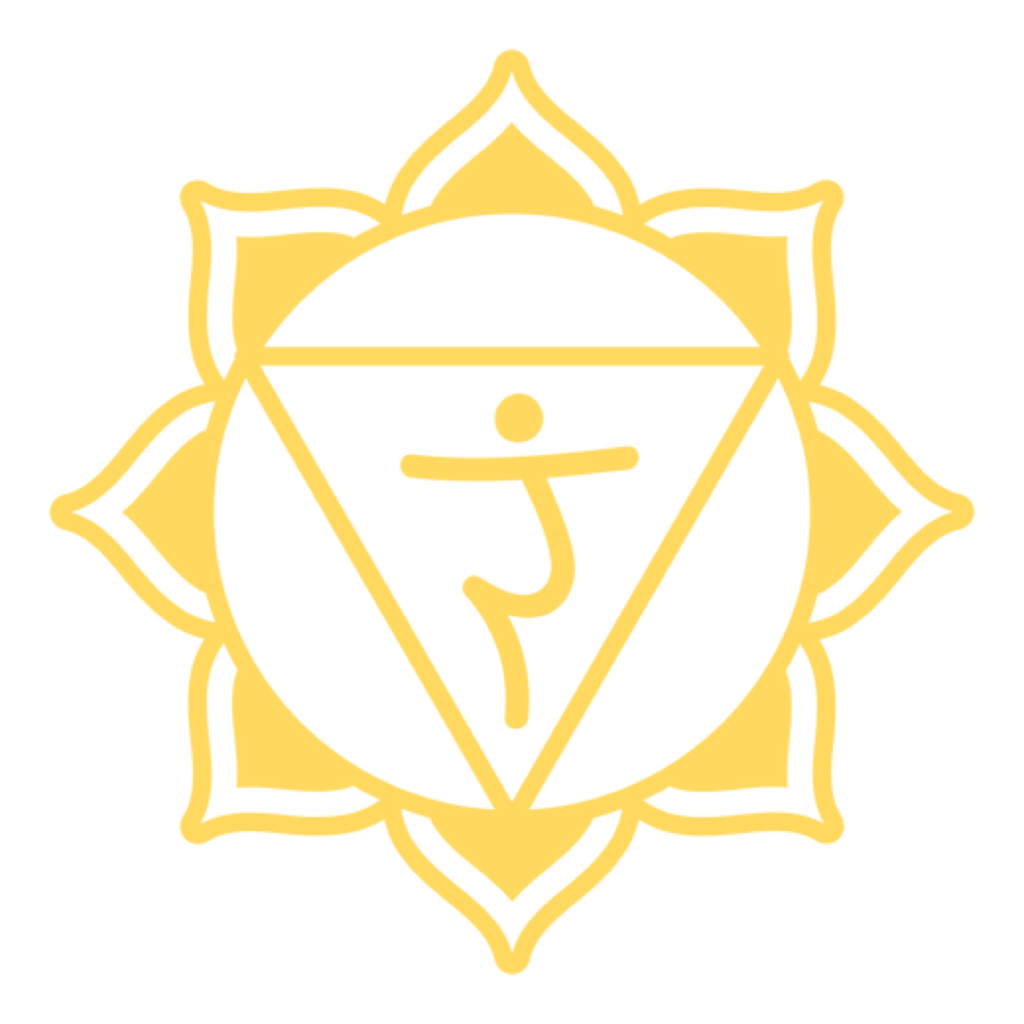
Did you know that your solar plexus is an actual complex network of nerves and ganglia located in the center of your torso? If you’ve ever experienced getting hit by something hard in the stomach and feeling like you had the wind knocked out of you, it’s likely you were actually hit right in the solar plexus. (Ouch!)
I lead with this because it’s important to differentiate between the solar plexus and the solar plexus chakra:
The solar plexus is the physical network of nerves and ganglia located above your navel in the center of your torso.
The solar plexus chakra, located in the same region, is the energy center in your body associated with your confidence, self-esteem, joy, motivation, and integrity.
Why Balancing the Solar Plexus Chakra is Important
Confidence is a fickle creature.
Have you ever experienced stretches of time – maybe days, weeks, or even months – where you felt invincible? During these periods, you felt confident, capable, and strong, and you undoubtedly knew your inherent worthiness.
And then one day, it all comes crashing down on you, and suddenly, you feel fearful, lack motivation, and lose sight of your purpose.
Personally, I’ve felt the highs and lows of all these experiences multiple times in the span of a single day.
And that’s one of the biggest reasons why balancing your solar plexus chakra is so important. Because confidence, high self-esteem, and radiant joy shouldn’t be fickle; these very attributes are your birthright.
Having a practice that allows you to balance and heal your solar plexus chakra means taking back your power. Instead of allowing confidence and joy to come and go like the ocean waves, you cultivate these powerful feelings inside of you. And maybe you’ll still experience moments of doubt, but I promise, they won’t last long because you know you have the power and tools inside of you to gain back the empowered beliefs and emotions you deserve to experience every single day.
In this post, we’re going to cover all things related to the solar plexus chakra: signs of balance and imbalance, affirmations, journal prompts, how to heal an imbalanced sacral chakra, and various associated attributes.
So let’s begin!
Solar Plexus Attributes
- Sanskrit Name: Manipura (“City of Jewels”; sometimes translated as “Lustrous Gem”)
- Location: A couple inches above the navel/Below the chest (You might associated this with the pit of your stomach.)
- Color: Yellow
- Body Parts: Pancreas, stomach, liver, gall bladder
- Symbol: Ten-petaled lotus with downward facing triangle in the center
- Element: Fire
- Mantra: RAM
- Gemstones: Citrine, topaz, tiger’s eye, yellow jasper, amber
- Essential Oils: Lemon, lemongrass, coriander, juniper, lime
Signs of a Balanced Solar Plexus Chakra
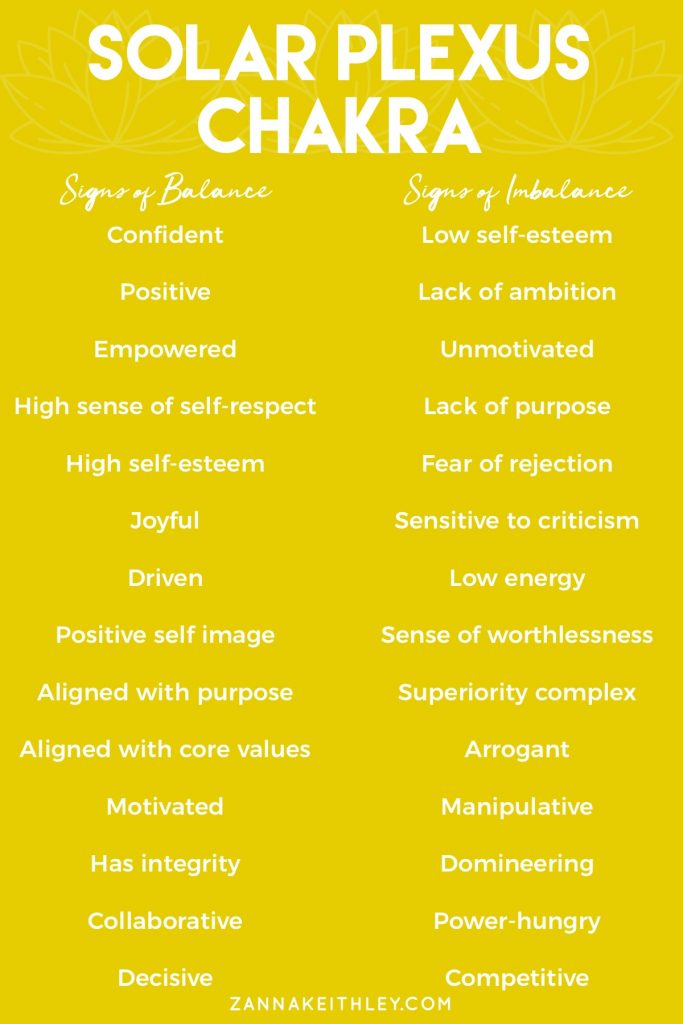
Have you ever met someone that just seemed to radiate with light? They walk with confidence, always seem to have a genuine smile on their face, and just seem like they have it all together. And on top of that, they’re really, really kind.
Chances are, they have a balanced solar plexus chakra.
Your solar plexus chakra is associated with all the self words: self-esteem, self-respect, self-image, and self-worth. Confidence is the word often associated with this energy center, but note that this is not cockiness, arrogance, or conceit. A person with a balanced solar plexus chakra will feel confident in themselves without demeaning or putting down others.
Here are some of the signs of a balanced solar plexus chakra:
- Confident
- Positive
- Empowered
- High sense of self-respect
- High self-esteem
- Joyful
- Driven
- Positive self image
- Aligned with purpose
- Aligned with core values
- Motivated
- Has integrity
- Collaborative
- Decisive/Confident in decision-making
Signs of an Imbalanced Solar Plexus Chakra
Imbalances in energy centers can go two ways: they might become underactive or overactive. (You might also hear the terms deficient or excessive.)
The underactive/deficient symptoms are associated with a lack of confidence while the overactive/excessive symptoms are associated with what happens when confidence turns into arrogance and a superiority complex.
Here’s a list of signs associated with an imbalanced solar plexus chakra:
- Low self-esteem
- Lack of ambition
- Unmotivated
- Lack of purpose
- Fear of rejection
- Sensitive to criticism
- Low energy
- Sense of worthlessness
- Superiority complex
- Arrogant
- Manipulative
- Domineering
- Power-hungry
- Competitive
Physical Signs of an Imbalanced Solar Plexus Chakra
In additional to emotional and mental symptoms, an imbalanced energy center also results in physical ailments. The solar plexus chakra is associated with the stomach, gall bladder, liver, and pancreas, so pay attention to these organs when you think you might be experiencing an imbalance. (For instance, have you recently experienced fatigue and/or poor digestion?)
Here are some of the physical ailments you may experience with an imbalanced solar plexus chakra:
- Fatigue
- Poor Digestion
- Liver Problems
- Low Metabolism
- Blood Sugar/Glycemic Issues
- Ulcers
Solar Plexus Chakra Affirmations
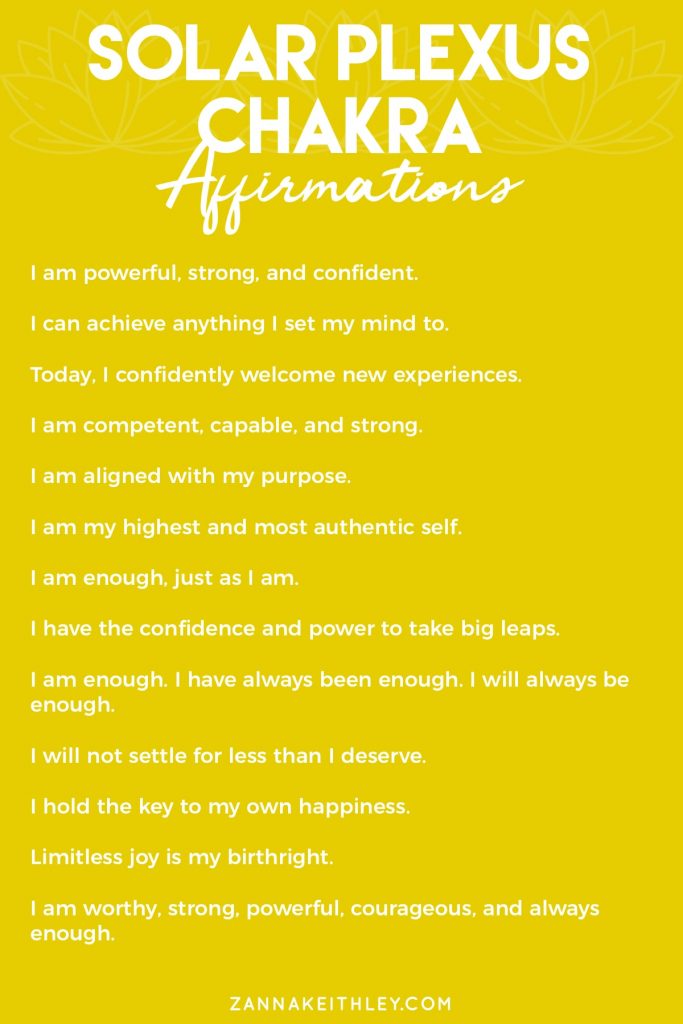
Affirmations are one of my favorite tools not only for healing chakras but for a total self-care routine. While it may seem difficult to come up with affirmations for some of the energy centers, there’s truly an infinite amount of affirmations a person could write for the solar plexus chakra.
Below, I’ve listed some powerful affirmations you can use to heal and balance your solar plexus chakra. But don’t limit yourself to this list; feel free to come up with your own awesome affirmations in which you assert your confidence, worthiness, joy, integrity, self-belief, self-esteem, self-worth, and limitless power to create the life of your dreams.
For more powerful solar plexus chakra affirmations, check out my post, 35 Solar Plexus Affirmations for Confidence, Motivation, and Positivity.
- I am powerful, strong, and confident.
- I can achieve anything I set my mind to.
- Today, I confidently welcome new experiences.
- I am competent, capable, and strong.
- I am aligned with my purpose.
- I am my highest and most authentic self.
- I am enough, just as I am.
- I have the confidence and power to take big leaps.
- I am enough. I have always been enough. I will always be enough.
- I will not settle for less than I deserve.
- I hold the key to my own happiness.
- Limitless joy is my birthright.
- I am worthy, strong, powerful, courageous, and always enough.
For even more empowering affirmations, check out 35 Solar Plexus Affirmations for Confidence, Motivation, and Positivity. And don’t forget to scroll to the bottom of this page to get your free printable affirmations and journal prompts!
Solar Plexus Chakra Journal Prompts
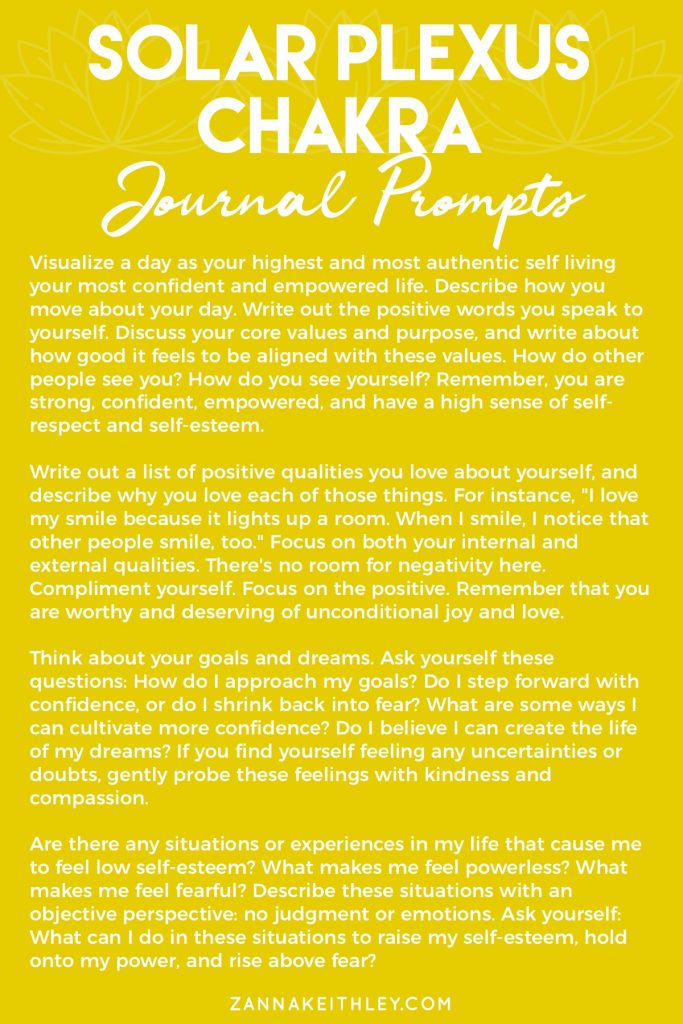
Journaling’s another practice that helps restore balance to your body’s energy centers while also supporting your overall wellbeing. Some people swear by journaling in the morning while others like to save it for nighttime to help them unwind. Choose what works best for you, and if possible, try to set aside some uninterrupted time to be alone with your thoughts, even if it’s just ten minutes.
Below are four powerful prompts you can use for healing your solar plexus chakra. As you sit down to journal, hold the intention to activate, balance, heal, or just get to understand your solar plexus chakra a little better. Let this be a time when you pledge to believe you are worthy and deserving of unconditional love, joy, and peace. And allow your words to be a reflection of that worthiness. (Because you are worthy of all these things and more!)
- Visualize a day as your highest and most authentic self living your most confident and empowered life. Describe how you move about your day. Write out the positive words you speak to yourself. Discuss your core values and purpose, and write about how good it feels to be aligned with these values. How do other people see you? How do you see yourself? Remember, you are strong, confident, empowered, and have a high sense of self-respect and self-esteem.
- Write out a list of positive qualities you love about yourself, and describe why you love each of those things. For instance, “I love my smile because it lights up a room. When I smile, I notice that other people smile, too.” Focus on both your internal and external qualities. There’s no room for negativity here. Compliment yourself. Focus on the positive. Remember that you are worthy and deserving of unconditional joy and love.
- Think about your goals and dreams. Ask yourself these questions: How do I approach my goals? Do I step forward with confidence, or do I shrink back into fear? What are some ways I can cultivate more confidence? Do I believe I can create the life of my dreams? If you find yourself feeling any uncertainties or doubts, gently probe these feelings with kindness and compassion.
- Are there any situations or experiences in my life that cause me to feel low self-esteem? What makes me feel powerless? What makes me feel fearful? Describe these situations with an objective perspective: no judgment or emotions. Ask yourself: What can I do in these situations to raise my self-esteem, hold onto my power, and rise above fear?
For more powerful journal prompts, check out 30 Journal Prompts to Open and Heal Your Solar Plexus Chakra.
Activating and Healing the Solar Plexus Chakra
Color Therapy
Immerse yourself in the color yellow. Eat yellow foods such as bananas, pineapple, yellow peppers, and squash. Light yellow, lemon-scented candles. Wear yellow. Paint with the color yellow. Sit or hang some yellow objects near your workspace. You can even write some empowering affirmations on yellow post-it notes and hang them up around you!
Have a (Safe) Bonfire (or Cozy Up by the Fireplace)
The solar plexus chakra’s element is fire, so this is the perfect time to have a safe bonfire with friends or enjoy some family time by the fireplace. You could also combine some time by the fire with other practices on this list, like doing some journaling by the fireplace.
Get Out in the Sun
If it’s summer and you’re not keen on starting the fireplace, another powerful practice to balance your solar plexus is to go for a walk or have a picnic in the sun. Spending some time in nature while immersing myself in beautiful sunshine is one of my favorite ways to bring balance to this energy center. Just don’t forget the sunscreen!
Journaling
The journal prompts above can help you get started here. Another incredibly powerful method is to incorporate affirmations into your journaling. You can use the affirmations above or come up with your own empowering solar plexus affirmations. Gratitude journaling is also an awesome practice. Write about all the positive associations with the solar plexus chakra that you’re grateful for: your high self-esteem and positive self image, your sense of worthiness, your alignment with your purpose, and so on!
Just remember, as you sit down to write, set the intention to balance your solar plexus chakra and see where it takes you.
Yoga
Yoga is one of the most powerful ways to heal the chakras as each energy center has associated poses to help restore balance.
For the solar plexus chakra, here are some of the best poses to balance this energy center:
- Warrior I
- Full Boat Pose
- Bow Pose
- Reverse Triangle Pose
- Warrior III
- Plank
And here’s a great video by Allie – The Journey Junkie that guides you through using yoga to ignite your power with the solar plexus chakra.
Meditation
For an unguided solar plexus chakra balancing meditation, find somewhere you feel safe and comfortable. You can choose whether or not you want to set a timer. If you’re on the floor, sit cross-legged with your back straight. If you’re on a chair, don’t cross your legs. Keep your feet on the floor. Close your eyes. Relax your eyebrows. Relax your shoulders. Slowly relax each body part as you take deep inhales through your nose and slow exhales, either out your mouth or through your nose.
Now, imagine a bright, yellow light just above your navel, below the chest. You might also see this as a yellow sun or a yellow, ten-petaled lotus. As you inhale, visualize the light growing brighter. As you exhale, visualize the light growing bigger. Repeat this throughout your meditation. If you want, at the end of your meditation, you can recite some powerful affirmations for balancing your solar plexus chakra.
For guided meditations, here’s some awesome (free!) ones from Insight Timer:
- Solar Plexus Chakra Balancing by Loula Love
- Cleanse the Solar Plexus Chakra by Leah Vermeeren
- Solar Plexus Chakra – Heal, Open & Align by Naomi Goodlet
Affirmations
I’m a big believer in using positive affirmations to cultivate confidence and assert your worthiness, and luckily, there’s an endless amount of positive affirmations you can use to balance your solar plexus chakra. Some of my favorite methods are to write them in my journal and to stick post-it notes with affirmations written on them on my work space or on my bathroom mirror. I also love to choose the normally mundane moments of life to silently repeat affirmations to myself, like when I’m driving to work or waiting for the oven timer to go off.
Gemstones
Some of the gemstones associated with the solar plexus chakra are citrine, topaz, tiger’s eye, yellow jasper, amber. If you’ve never used crystals before, don’t feel intimidated! Some simple practices to use gemstones and crystals are to hold them during meditation, carry them in your pocket during the day, or keep them somewhere nearby while you’re working.
Essential Oils
Essential oils are a perfect way to restore balance to the solar plexus chakra, and you can easily find ways to combine using essential oils with other practices on this list. For instance, you can use them in your diffuser while journaling with some beautiful crystals nearby. Just remember, as with everything on this list, be intentional with your actions. So before you sit down to do all of these practices, set the powerful intention to balance and heal your solar plexus chakra first.
Here are some of the essential oils associated with the solar plexus chakra:
- Lemon
- Lemongrass
- Coriander
- Juniper
- Lime
- Fennel
- Ginger
- Grapefruit
And there you have it: the slightly long but detailed answer to the question, “What is the solar plexus chakra?” For more chakra resources, positive affirmations, self-love tools, and more, be sure to follow me on Pinterest and Instagram!
Are your ready for your freebies? Download your free printables below!

Pin this for later! What is the Solar Plexus Chakra? Activate, Balance, and Heal 
Zanna Keithley is an author, poet, and social media content creator who writes short prose dedicated to inspiring readers to follow their dreams, trust their intuition, and create beautiful and fulfilling lives. You can find her original writing on Instagram @zannakeithley.
-
What is the Sacral Chakra? Activate, Balance, and Heal
Ready to learn all about the sacral chakra? Then this post is for you! If you missed my post on the root chakra, you can read more about the body’s first energy center here. And for even more information on chakras, including what a chakra is and an overview on the seven main chakras, check out A Beginner’s Guide to Understanding and Unblocking Your Chakras.
Also, be sure to scroll to the bottom of this page for some awesome freebies! You’ll receive 35 free printable affirmations and 30 journal prompts to open and heal the sacral chakra. Don’t miss these powerful healing tools!
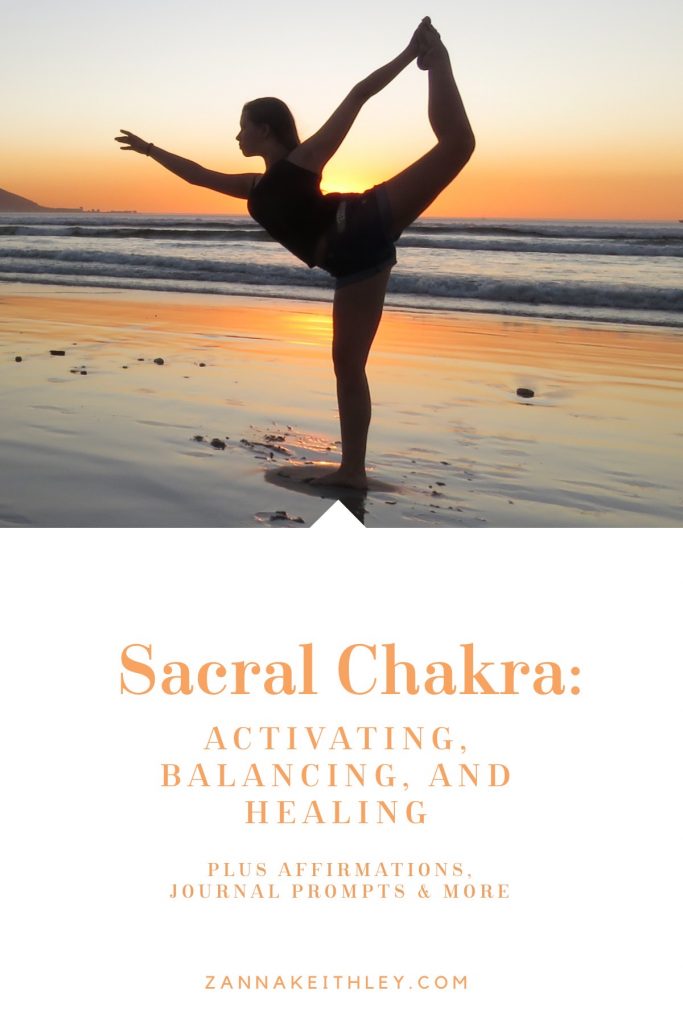
Pin this for later! Sacral Chakra: Activating, Balancing, and Healing Discover More About Chakras
Discover more about chakras using the links below, plus get journal prompts and affirmations for each of your body’s main energy centers! And for deeper insight into chakras as well as guidance on profound chakra healing, check out my Ultimate Chakra Healing Bundle, which includes a Chakra Healing eBook, Chakra Healing Workbook, and 8-Week Chakra Healing Guide. You can also discover more in my online shop.
What is the Sacral Chakra?
Located below your navel in your lower abdomen, the sacral chakra is your energy center for creativity, passion, joy, and pleasure. When we experience blockages to this energy center, we often become withdrawn, tense, insecure, and needy.
And unfortunately, blockages to the sacral chakra aren’t uncommon, especially if you live in a culture that prioritizes work, efficiency, and practicality over creativity, fun, and play.
Even as someone who has always embraced creativity, I’ve experienced blockages to my sacral chakra for months at a time. A few years ago, I remember having the thought that I didn’t daydream anymore. It was an unexpected and stunning realization, and I couldn’t quite pinpoint when and how it happened. I just knew that I no longer lost myself in my imagination like I used to, and at the time, I wasn’ t sure if I ever would again.
Back then, I didn’t understand that my body had powerful energy centers or that, when balanced, energy flowed freely throughout my body. But in hindsight, I can clearly see how my sacral chakra had been blocked from this energy flow.
I had “grown up,” and as a result, I traded in my inner child for responsible adulthood – something I thought I was supposed to do now that I was out of school, paying bills, and supporting myself.
But since then, I’ve discovered one of the greatest lessons of my life (something that I actually knew inherently as a child but had lost sight of in the confusion of becoming an adult):
Play is not irresponsible. Creativity is not impractical. Fun is not frivolous.
In fact, it is irresponsible not to prioritize these behaviors and pastimes in my everyday life.
Why Balancing the Sacral Chakra is Important
Joy is your birthright.
Is that hard to say?
I know it used to be for me. It was hard for me to believe that anything good was my birthright. And to think that I deserved good stuff? Absolutely not. It felt all kinds of wrong.
But these aren’t the kind of thoughts we have when we act out of a place of love.
These are the kinds of thoughts we have when we’ve been conditioned to believe our worth is tied to our achievements.
Because the truth is, you do deserve joy. And pleasure. And you deserve to feel good in your skin. And to love yourself fully, without conditions.
And if that still doesn’t cut it for you, a balanced sacral chakra is associated with being more open, honest, forgiving, and compassionate.
If you live in a western culture that prioritizes work over play, hustle over relaxation, and being a responsible adult over embracing your inner child, then learning to recognize the signs of an imbalanced sacral chakra – and how to heal this energy center – is pivotal for embracing lifelong happiness.
(Note that I’m definitely not saying work and being a responsible adult are bad things! It’s all about balance!)
In this post, we’re going to cover all things related to the sacral chakra: signs of balance and imbalance, affirmations, journal prompts, how to heal an imbalanced sacral chakra, and various associated attributes.
Sacral Chakra Attributes
- Sanskrit Name: Svadhishthana (Sva = “self”; shthana = “place”)
- Location: Lower abdomen (below your navel)
- Color: Orange
- Body Parts: Womb, Kidney, Bladder, Lower Back, Reproductive Organs
- Symbol: Six-petaled lotus with a moon crescent in the center
- Element: Water
- Mantra: VAM
- Gemstones: Orange Calcite, Jasper, Carnelian, Red Tiger’s Eye, Coral, Fire Opal
- Essential Oils: Orange, Tangerine, Cinnamon, Bergamot, Neroli, Cypress
Signs of a Balanced Sacral Chakra
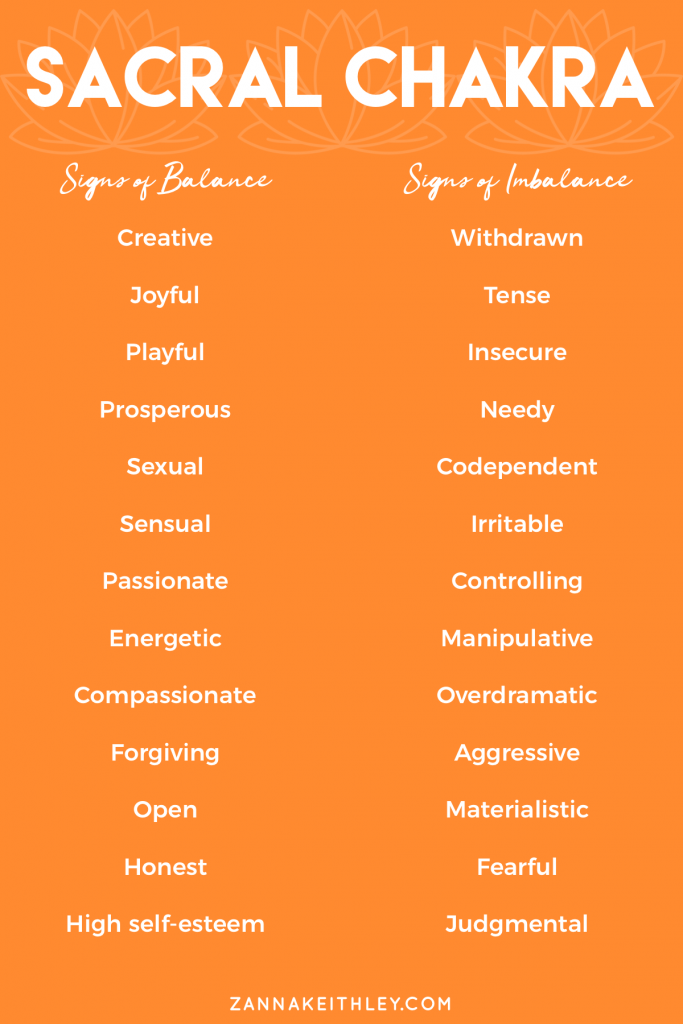
The sacral chakra is the energy center for creativity, joy, sexuality, and sensuality. While the root chakra is associated with safety and stability, the sacral chakra is associated with seeking pleasure. While these seem unrelated from one another, this is one of the many examples of how the chakras aren’t just seven separate energy centers; rather, they’re one complete system in which energy flows freely (when balanced) among all energy centers.
You see, when our root chakra is balanced, we feel safe, secure, stable, and centered. Feeling safe in our body and in our physical place in life is one of our most basic needs. But as you can imagine, if the root chakra was blocked, it’s likely that the sacral chakra would become imbalanced as well. When we don’t have a steady foundation, we may overcompensate by becoming more controlling, manipulative, and fearful, and it would be difficult to engage in creativity, play, and joy.
Below are some of the signs and characteristics of having a balanced sacral chakra:
- Creative
- Joyful
- Playful
- Prosperous
- Sexual
- Sensual
- Passionate
- Energetic
- Compassionate
- Forgiving
- Open
- Honest
- High self-esteem
Signs of an Imbalanced Sacral Chakra
When the sacral chakra is balanced, we feel joyful, creative, open, passionate, and honest. But when our energy is blocked from flowing freely through this energy center, our joy and passion shrinks. We become withdrawn, tense, and insecure.
It’s also possible for this energy center to become overactive. When this happens, we’re more prone to becoming controlling, manipulative, and aggressive.
Here are some of the signs associated with an imbalanced sacral chakra:
- Withdrawn
- Tense
- Insecure
- Needy
- Codependent
- Irritable
- Controlling
- Manipulative
- Overdramatic
- Aggressive
- Materialistic
- Fearful
- Judgmental
- Prone to addictive behavior
- Lack of creativity
- Fear of pleasure
Physical Signs of an Imbalanced Sacral Chakra
An imbalance in our energy centers affects not only our emotional and mental health but our physical health as well. As the sacral chakra is associated with our reproductive organs, the common physical ailments are correlated to these organs. Other affected body parts include those in neighboring areas of the body, such as the lower back.
These are some of the physical ailments you may experience with an imbalanced sacral chakra:
- Constipation
- Urinary problems
- Lower back pain
- Kidney issues
- Yeast infections
Sacral Chakra Affirmations
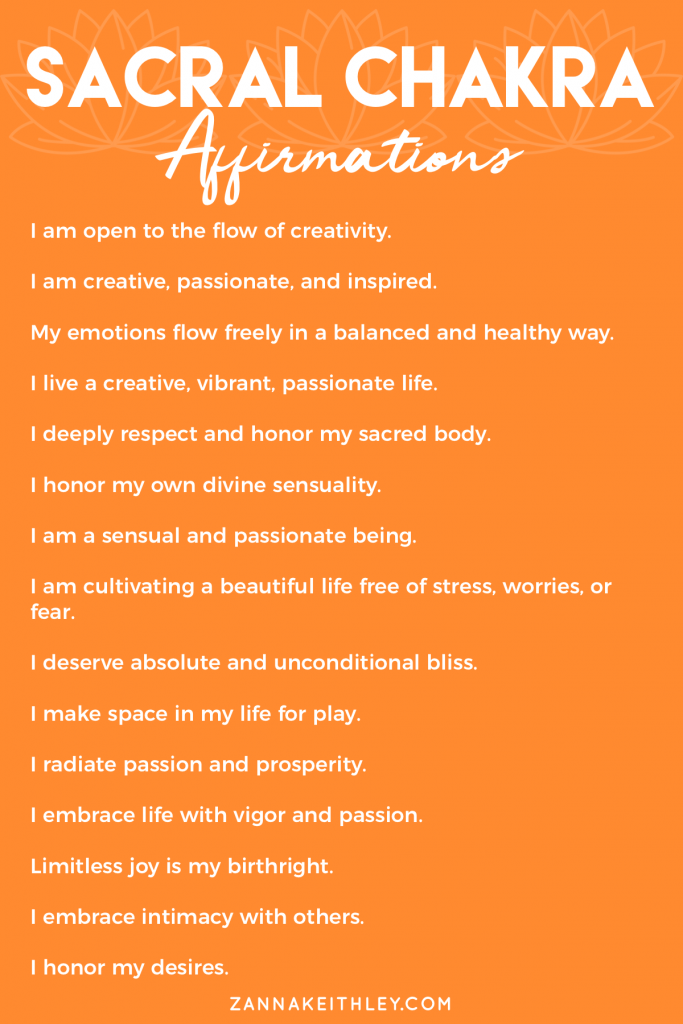
Affirmations are a powerful tool in your total self-care routine. When reciting affirmations to balance your sacral chakra, remember to embrace your joy and creativity. Have fun with it!
For example, take the affirmation, “I embrace life with vigor and passion.” You don’t have to recite this statement with the pep of a high school cheerleader, but the affirmation itself won’t help you if you recite it with tension, monotony, or lack of enthusiasm. So whether you’re saying it silently or aloud, make sure to really feel the words in your being. In this example, you want to actually feel vigorous and passionate.
Affirmations
- I am open to the flow of creativity.
- I am creative, passionate, and inspired.
- My emotions flow freely in a balanced and healthy way.
- I live a creative, vibrant, passionate life.
- I deeply respect and honor my sacred body.
- I honor my own divine sensuality.
- I am a sensual and passionate being.
- I am cultivating a beautiful life free of stress, worries, or fear.
- I deserve absolute and unconditional bliss.
- I make space in my life for play.
- I radiate passion and prosperity.
- I embrace life with vigor and passion.
- Limitless joy is my birthright.
- I embrace intimacy with others.
- I honor my desires.
For more powerful sacral chakra affirmations, be sure to check out my post, 35 Sacral Chakra Affirmations to Live a Passionate, Fun, Creative Life. And be sure to scroll to the bottom of this page to get your free printable affirmations and journal prompts!
Sacral Chakra Journal Prompts
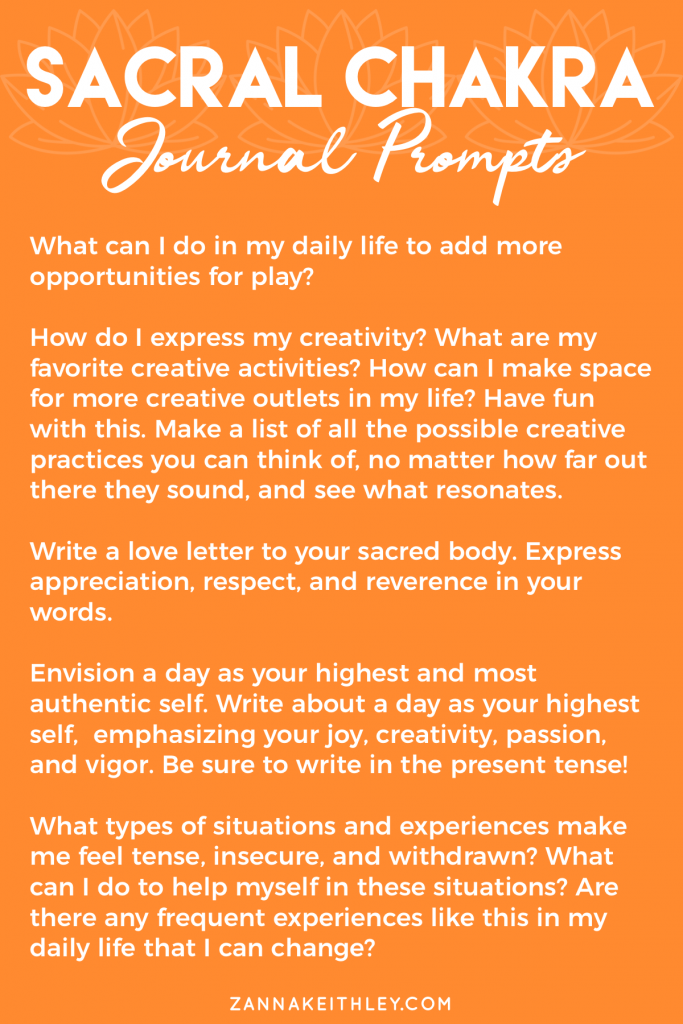
Journaling is a powerful method for healing your body’s energy centers. There are no hard-and-fast rules for when to journal or how long you should spend journaling. Just allow yourself time to consciously consider the journal prompts. Don’t try to give the “right” answers to questions. And also, don’t feel like you need to stick with the prompts. If you start out writing about all the opportunities in your life for play, and this drifts off into a memory about making sandcastles when you were a child, let it! Embrace your inner child and see where your imagination takes you.
Journal Prompts
- What can I do in my daily life to add more opportunities for play?
- How do I express my creativity? What are my favorite creative activities? How can I make space for more creative outlets in my life? Have fun with this. Make a list of all the possible creative practices you can think of, no matter how far out there they sound, and see what resonates.
- Write a love letter to your sacred body. Express appreciation, respect, and reverence in your words.
- Envision a day as your highest and most authentic self. Write about a day as your highest self, emphasizing your joy, creativity, passion, and vigor. Be sure to write in the present tense!
- What types of situations and experiences make me feel tense, insecure, and withdrawn? What can I do to help myself in these situations? Are there any frequent experiences like this in my daily life that I can change?
For more powerful sacral chakra journal prompts, check out my post, 30 Journal Prompts to Open and Heal Your Sacral Chakra.
Activating and Healing the Sacral Chakra
Below are 11 powerful practices for sacral chakra healing. For deeper insight into how to open, balance, and heal the sacral chakra, check out my post, Sacral Chakra Healing: Open & Balance the Sacral Chakra.
Color Therapy
Immerse yourself in all things orange! This could mean eating orange foods, such as mangoes, cantaloupe, and oranges; wearing orange clothing; surrounding yourself with orange items; painting with the color orange; and lighting orange candles, among other things. If you don’t generally have a lot of orange around, see if you can pick up a few small items to have around for moments when you feel an imbalance in this energy center.
Swimming
The sacral chakra’s element is water, so a fun and relaxed day at the pool, lake, or beach is a perfect way to restore balance to this energy center. If you’re not big on swimming, relaxing near a body of water will still get you these same benefits.
Take a Bath
If you’re not able to go to any pools or lakes, create a relaxing water environment right at home. Draw a warm bath, turn off the lights, and maybe even light an orange-cinnamon scented candle.
And if baths aren’t your thing, take a nice, warm shower. You can even close your eyes for a few minutes and do a mini-meditation, visualizing a bright orange light below your navel.
Create!
The sacral chakra is the energy center of creativity, so one of the best ways to heal this energy center is to create! Paint, draw, write, cook, bake, or choose your activity of choice to express your divine creativity. Try not to follow an outline, template, or recipe. Simply allow your inner creative to flow freely! This can be especially helpful if you’ve noticed your life has revolved around work, deadlines, and other stressors of daily life.
Journaling
Find a quiet place where you can focus on writing, and set the intention to balance your sacral chakra before you begin. If you want, you can use any of the prompts above. You could also incorporate affirmations into your journaling by writing down powerful sacral chakra affirmations in your writing.
Dancing
Some of the signs of an imbalanced sacral chakra are feeling tense, withdrawn, insecure, and fearful. Dancing is a beautiful way to release tension and embrace flow. Find somewhere you feel comfortable, put on some music that makes you feel good, and let yourself flow without judgment. Light some candles or use some essential oils if possible. You can make this an even more powerful practice by immersing yourself in the color orange while dancing.
Yoga
Each chakra has associated yoga poses to help heal imbalanced energy. For an imbalanced sacral chakra, choose hip-opening positions.
Here are just some of the poses for healing the sacral chakra that you can incorporate into your yoga practice:
- Pigeon
- Butterly
- Cobra
- Frog
- Goddess squat
Here’s a great video from Allie – The Yoga Junkie on cleansing your sacral chakra.
Meditation
A powerful practice to heal your sacral chakra is to visualize a bright orange light just below your belly button. See the light growing brighter as you inhale and bigger as you exhale. You might think of this light like a beautiful orange sun.
Here are some root chakra guided meditations using the free Insight Timer app:
- Sacred Sacral Chakra Balancing by Loula Love
- Sacral Chakra Meditation by Sarah Da Silva
- 2nd Chakra Svadhisthana Sacral Meditation by Amelia Lina Sawyer
Affirmations
Affirmations are a great tool to help heal any of your energy centers because they can be recited (either silently or out loud) almost anywhere. To make the most of affirmations, see if you can combine it with another practice. For healing the sacral chakra, you might repeat them while you’re in the shower or bath. You could also incorporate them in your journaling or recite them as you hold your crystals.
Gemstones
Some of the gemstones associated with the sacral chakra are orange calcite, jasper, carnelian, red tiger’s eye, coral, fire opal, moonstone, amber, and orange amethyst. You can hold these crystals during meditation, carry them in your pocket during the day, or keep them nearby on your desk as you work.
Here’s a few more posts to help you get started with using crystals and gemstones to heal the chakras:
Essential Oils
To open and activate the sacral chakra, you can use the essential oil(s) of choice in your diffuser, add them to your bath, or apply to your skin below the navel. (If applying to your skin, please make sure to use high-quality oils and always follow directions for dilution. Also note all other safety instructions, such as amount of time you should wait before going out in the sun. I am not a qualified aromatherapy practitioner, so if you have any questions about safety, please make sure to refer your questions to a professional. Always err on the side of caution.)
Here are some of the best essential oils for healing the sacral chakra:
- Orange
- Jasmine
- Rose
- Geranium
- Clove
- Nutmeg
- Cinnamon
For more information on how to use essential oils to heal the chakras, check out my post, A Guide to Essential Oils for Chakra Healing.
As always, with all the practices listed above, make sure to be intentional with your thoughts and actions. Whether you’re reciting affirmations, going swimming, using essential oils, or utilizing any of the other practices on this list, set the powerful intention to balance and heal the sacral chakra, and let that intention guide you as you move forward.
Are you ready for your freebies? Download your free printables below!
For more more chakra resources, plus uplifting affirmations and self-love encouragement, be sure to follow me on Pinterest and Instagram!

Pin this for later! Sacral Chakra: Activating, Balancing, and Healing 
Zanna Keithley is an author, poet, and social media content creator who writes short prose dedicated to inspiring readers to follow their dreams, trust their intuition, and create beautiful and fulfilling lives. You can find her original writing on Instagram @zannakeithley.
-
What is the Root Chakra? Activate, Balance, and Heal
This post is dedicated to all things root chakra, your body’s first energy center. This is the first of a seven-part series on the seven main chakras. For more information on chakras, including what a chakra is and an overview on the seven chakras, check out A Beginner’s Guide to Understanding and Unblocking Your Chakras.
Be sure to scroll to the bottom of this page for some awesome freebies! You’ll receive 35 free printable affirmations and 30 journal prompts to open and heal the root chakra. Don’t miss these powerful healing tools!
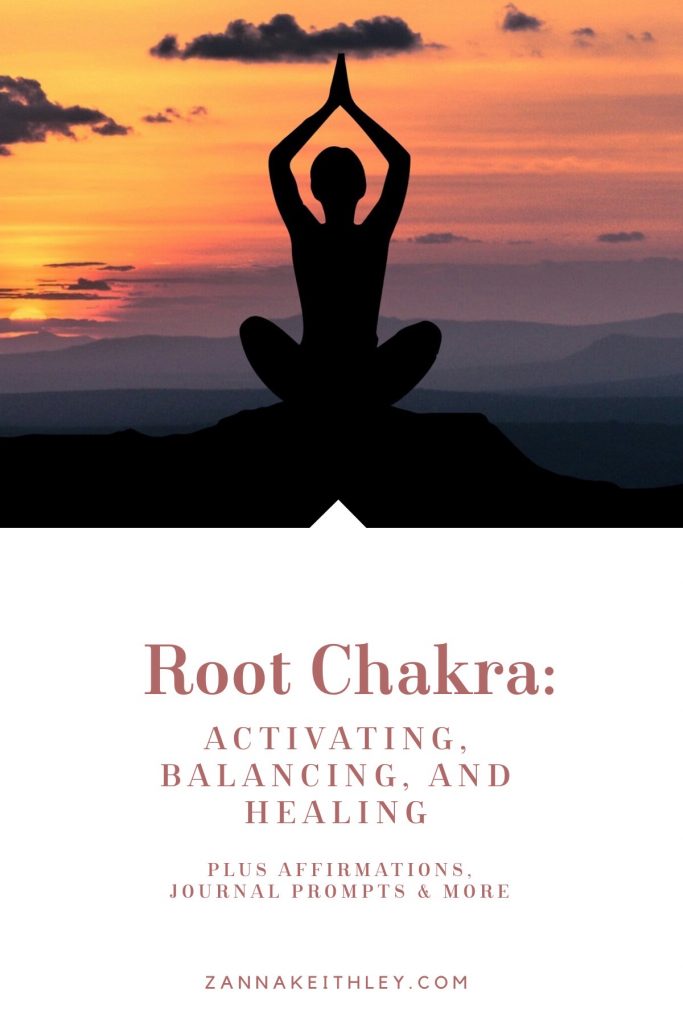
Pin this for later! Root Chakra: Activating, Balancing, and Healing Discover More About Chakras
Discover more about chakras using the links below, plus get journal prompts and affirmations for each of your body’s main energy centers! And for deeper insight into chakras as well as guidance on profound chakra healing, check out my Ultimate Chakra Healing Bundle, which includes a Chakra Healing eBook, Chakra Healing Workbook, and 8-Week Chakra Healing Guide. You can also discover more in my online shop.
What is the Root Chakra?

To begin a series on chakras, it’s fitting to start with the root chakra for many reasons.
For one, it’s often called the “1st” chakra. Located at the base of your spine, the root chakra is the lowest energy center on your body. When you hear someone refer to 1st chakra, 2nd chakra, 3rd chakra, etc., this means they’re usually starting with this lowest energy center and working upwards.
But even deeper than that, the root chakra is your foundation. You can think of this like a foundation of a house, holding the house up and keeping it safe and secure. You might also compare it to the roots of a tree, keeping the tree steady, stable, and supported.
Without this strong foundation keeping these structures upright, any strong gust of wind could knock it down at any moment.
This is the same for us.
Why Balancing the Root Chakra is Important
We may not think of ourselves as having foundations because we are constantly moving.
However, even though we’re on the move, most of the time, we have one or more body parts, most often our feet, connected to the ground. This is our physical foundation.
Beyond our physical foundation, we have a foundation of basic needs we need to survive. You might think of Maslow’s Hierarchy of Needs here. At our most basic level, before anything else, we have physiological and safety needs, such as food, water, warmth, rest, security, and safety.
So without a solid foundation to support us, it would be difficult, likely even impossible, to fully meet our other needs such as intimate relationships and creativity.
This is why it makes sense to start with the root chakra. Because without a balanced root chakra, it would be nearly impossible to find balance in our other energy centers. Likely, some would become overstimulated while others would become understimulated.
It’s important to remember that even though these seven main chakras are all separate energy centers, they act as one complete system. When one is out of balance, it’s likely this will affect one or more of the others.
In this post, we’re going to cover all things related to the root chakra: signs of balance and imbalance, affirmations, journal prompts, how to heal an imbalanced root chakra, and various associated attributes.
Root Chakra Attributes
- Sanskrit Name: Muladhara (Mula: “root”; Adhara: “support” or “base”)
- Location: Base of spine
- Color: Red
- Body Parts: Legs, tailbone, kidneys, prostate, bladder, colon
- Symbol: Lotus with four petals
- Element: Earth
- Mantra: LAM
- Gemstones: Obsidian, Hematite, Bloodstone, Red Jasper, Black Tourmaline, Garnet, Onyx, Smoky Quartz
- Essential Oils: Cedarwood, rosemary, sandalwood, basil, and patchouli. (Earthy scents.)
Signs of a Balanced Root Chakra
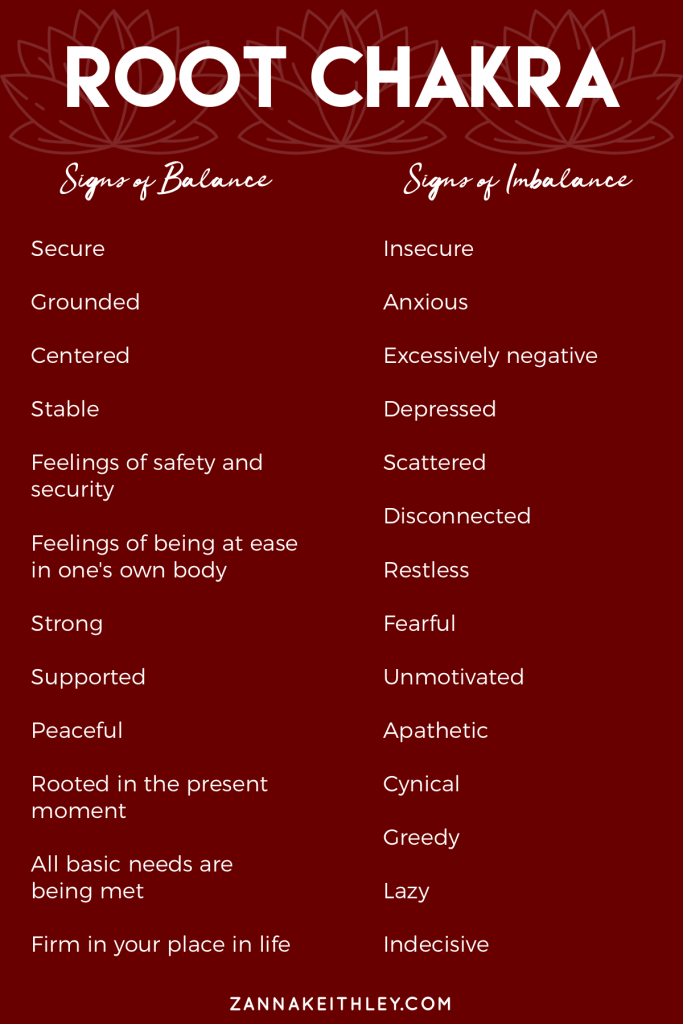
A balanced root chakra is associated with feelings of steadiness, security, safety, and ease. Again, you can think of yourself as a tree with your roots firmly holding your place in the ground. The wind may come, but it will not bend or break your solid foundation.
We also associate a balanced root chakra with how our mind and spirit feel inside our body. Generally speaking, there’s a sense of safety in one own’s body. You can move with ease and feel secure just as you are.
Here’s a list of signs and feelings attributed to a balanced root chakra:
- Secure
- Grounded
- Centered
- Stable
- Feelings of safety and security
- Feelings of being at ease in one’s own body
- Strong
- Supported
- Peaceful
- Rooted in the present moment
- All basic needs are being met
- Firm in your place in life
Signs of an Imbalanced Root Chakra
As we associate a balanced root chakra with feelings of safety, stability, and ease in our bodies, an imbalanced root chakra results in feelings of instability, restlessness, and fear. This can manifest in many ways. For instance, when the COVID-19 pandemic started, one of the main news headlines was how people were hoarding items such as toilet paper. While this seemed unreasonable and greedy, believe it or not, it actually makes sense.
You see, the pandemic shattered a lot of people’s safe and stable foundations. Because of this, many overcompensated by trying to gain back a feeling of stability. Hoarding and greed are two ways we overcompensate when our foundations are shattered. So by hoarding extra toilet paper and food items, this was an attempt by many to restabilize their shaky foundations.
Here’s a list of signs and attributes of an imbalanced root chakra:
- Insecure
- Anxious
- Excessively negative
- Depressed
- Scattered
- Disconnected
- Restless
- Fearful
- Unmotivated
- Apathetic
- Cynical
- Greedy
- Lazy
- Indecisive
Physical Signs of an Imbalanced Root Chakra
An imbalanced root chakra doesn’t just affect our emotions; it affects our physical body as well. As this energy center is located at the base of the spine, an imbalance of energy most often affects the body parts and organs in the surrounding areas.
I just want to note that I often see “eating disorders” listed under the physical symptoms, and I listed it below, but as many of us know, an eating disorder is much, much more than a physical thing. This also involves our mental and emotional health. When our foundations aren’t stable, food is often used as a means for taking back control. Undereating and restricting food is often a way for one to exercise control over their lives, especially when it feels like the external world is completely out of control. Overeating can also be a result of an unsteady foundation, especially overeating comfort foods, as one looks for an easy way to bring themselves comfort in the midst of uncertainty.
But no two stories are ever the same, and I don’t want to oversimplify something as complex as an eating disorder. Here is more information about eating disorders from the National Eating Disorders Association.
These are some of the physical ailments you may experience with an imbalanced root chakra:
- Constipation
- Digestive Issues
- Eating Disorders
- Lower Body Pain
- Sciatica
- Anemia
- Numbness
Root Chakra Affirmations
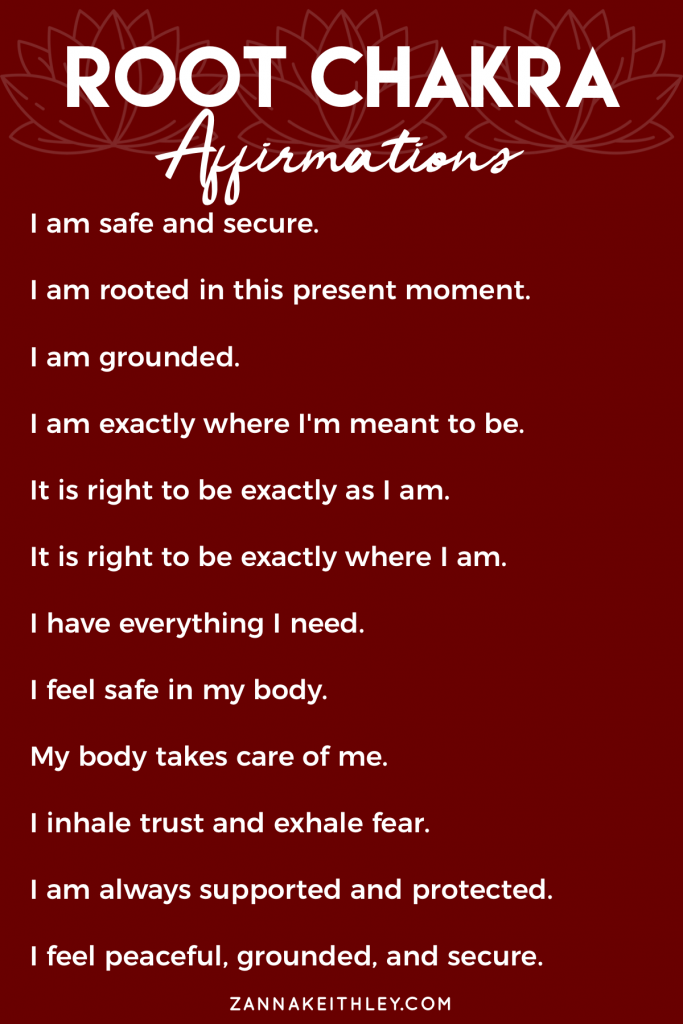
I absolutely love affirmations and try to incorporate them into as many areas of my life as possible. And luckily, it’s really pretty easy. Affirmations can be used pretty much anytime: when you first wake up, while you’re in the shower, as you’re commuting to work, while you’re waiting in line at the grocery store, or before you go to bed at night.
To make the most of root chakra affirmations, first set the intention to balance your root chakra, and be intentional with your words. One of my favorite ways to use affirmations is to incorporate them into journaling, or even by keeping a journal solely for affirmations. The key here is to always use the present tense and to feel the positive emotions associated with the words as you repeat or write them down.
And for more grounding root chakra affirmations, check out my post, 35 Root Chakra Affirmations to Remain Strong, Steady, and Grounded. And be sure to scroll to the bottom of this page to get your free printable affirmations and journal prompts!
Affirmations
- I am safe and secure.
- I am rooted in this present moment.
- I am grounded.
- I am exactly where I’m meant to be.
- It is right to be exactly as I am.
- It is right to be exactly where I am.
- I have everything I need.
- I feel safe in my body.
- My body takes care of me.
- I inhale trust and exhale fear.
- I am always supported and protected.
- I feel peaceful, grounded, and secure.
Root Chakra Journal Prompts
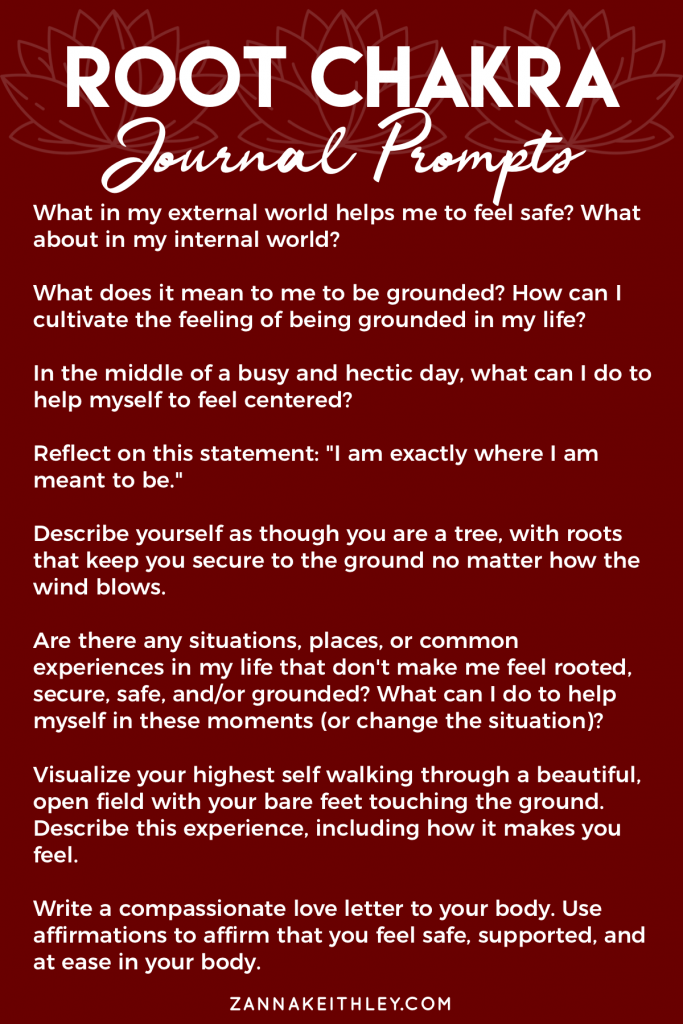
Journaling is one of my favorite self-care practices, and it’s a great method for healing chakras and realigning your energy. I like to journal for thirty minutes first thing after I wake up so I can set my intentions for the day and start the day off with some positivity. However, everyone’s journaling practice is different and personal to them. Choose the time that works best for you, and allot as much or as little time as you can allow, even if it’s just ten minutes.
And for more powerful journal prompts, check out 30 Journal Prompts to Open and Heal the Root Chakra.
Journal Prompts
- What in my external world helps me to feel safe? What about in my internal world?
- What does it mean to me to be grounded? How can I cultivate the feeling of being grounded in my life?
- In the middle of a busy and hectic day, what can I do to help myself to feel centered?
- Reflect on this statement: “I am exactly where I am meant to be.”
- Describe yourself as though you are a tree, with roots that keep you secure to the ground no matter how the wind blows.
- Are there any situations, places, or common experiences in my life that don’t make me feel rooted, secure, safe, and/or grounded? What can I do to help myself in these moments (or change the situation)?
- Visualize your highest self walking through a beautiful, open field with your bare feet touching the ground. Describe this experience, including how it makes you feel.
- Write a compassionate love letter to your body. Use affirmations to affirm that you feel safe, supported, and at ease in your body.
Activating & Healing the Root Chakra
Below are 8 powerful practices for root chakra healing. For deeper insight into how to open, balance, and heal the root chakra, check out my post, Root Chakra Healing: Open & Balane the Root Chakra.
Color Therapy
When you feel like one of your chakras is imbalanced, color therapy is one of the most common and prominent ways to bring that energy center back into balance. Color therapy is immersing yourself in the color associated with that chakra. For the root chakra, this means immersing yourself in all things red. Eat red food. Wear red clothes. Light red candles. (If they’re earth-scented, that’s even better.) If possible, surround yourself with as many red items in your immediate environment as possible. You could even have some painting materials on hand for these moments. Let your inner creative come out and paint an image entirely in the color red.
Journaling
Affirmations journaling is especially powerful in these moments. Affirm to yourself that you are safe and secure and exactly where you are meant to be. You can also use any of the journaling prompts above. I also like to visualize that I’m my highest and most authentic self and write as my highest self. For the root chakra specifically, you can write as your highest and most centered self living your safest, most grounded life. Describe the feelings of being secure in your body as well as feeling secure in the present moment.
Walk Barefoot in the Dirt
The root chakra is associated with the earth, so this is the perfect time to immerse yourself in nature and let your bare feet touch the ground. Of course, this may be more difficult for some depending on where you live. If possible, try to find a place to immerse yourself in nature for a bit. Our nature is truly our foundation, so this allows us to (no pun intended) get back to our roots.
Yoga
Each chakra has associated yoga poses to help heal imbalanced energy. For an imbalanced root chakra, choose poses that allow you to feel balanced and safe. Some poses might include Mountain Pose, Downward Dog, Tree Pose, Lunge Pose, and Warrior II.
Here’s a great video from Yoga With Adriene specifically dedicated to the root chakra.
Meditation
For an unguided root chakra meditation, visualize a glowing red light at the base of your spine. See that light get brighter as you inhale and bigger as you exhale. You might also visualize a red lotus flower at the base of your spine.
Here are some root chakra guided meditations using the free Insight Timer app:
- Root Chakra Love by Hannah Devries
- Root Chakra Therapy by Cory Cochiolo
- Root Chakra Meditation by Sarah Da Silva
Affirmations
I mentioned this one in the journaling section, but if you’re unable to sit down and write, repeating affirmations either silently or aloud is a powerful practice. You can do this while you’re getting ready for the day, showering, commuting to work – anytime, really. You could also combine this with other practices on the list, such as taking a walk in nature.
Gemstones
Use crystals associated with the root chakra to activate this energy center. A powerful way to receive the healing power of the crystal is to hold it during meditation. You can also carry crystals around with you during the day. A few examples of gemstones associated with the root chakra are obsidian, hematite, onyx, bloodstone, red jasper, black tourmaline, and garnet.
Here’s a few more posts to help you get started with using crystals and gemstones to heal the chakras:
Essential Oils
Use earth-scented essential oils, such as cedarwood, rosemary, sandalwood, basil, and patchouli.
With any of the practices above, don’t forget to be intentional with your actions. For instance, if you light candles or use essential oils, do so with the intention to heal or activate your root chakra. Then, let these intentions be your guide as you take the next right step in balancing your energy centers.
For more information on how to use essential oils to heal the chakras, check out my post, A Guide to Essential Oils for Chakra Healing.
And there you have it: how to activate, balance, and heal the root chakra, plus journal prompts and affirmations to help you on your journey!
For more more chakra resources, plus uplifting affirmations and self-love encouragement, be sure to follow me on Pinterest and Instagram!
Are you ready for your freebies? Download your printables below!

Pin this for later! Root Chakra: Activating, Balancing, and Healing 
Zanna Keithley is an author, poet, and social media content creator who writes short prose dedicated to inspiring readers to follow their dreams, trust their intuition, and create beautiful and fulfilling lives. You can find her original writing on Instagram @zannakeithley.
-
10 Ways to Cultivate Mindfulness Today
As a follow-up to my blog post, What is Mindfulness? Plus 15 Powerful Mindfulness Quotes, I’m giving you 10 effective ways to cultivate mindfulness as you become more conscious of your thoughts and start living in the present moment. The best part? Most of these are simple practices you can start doing at home today.
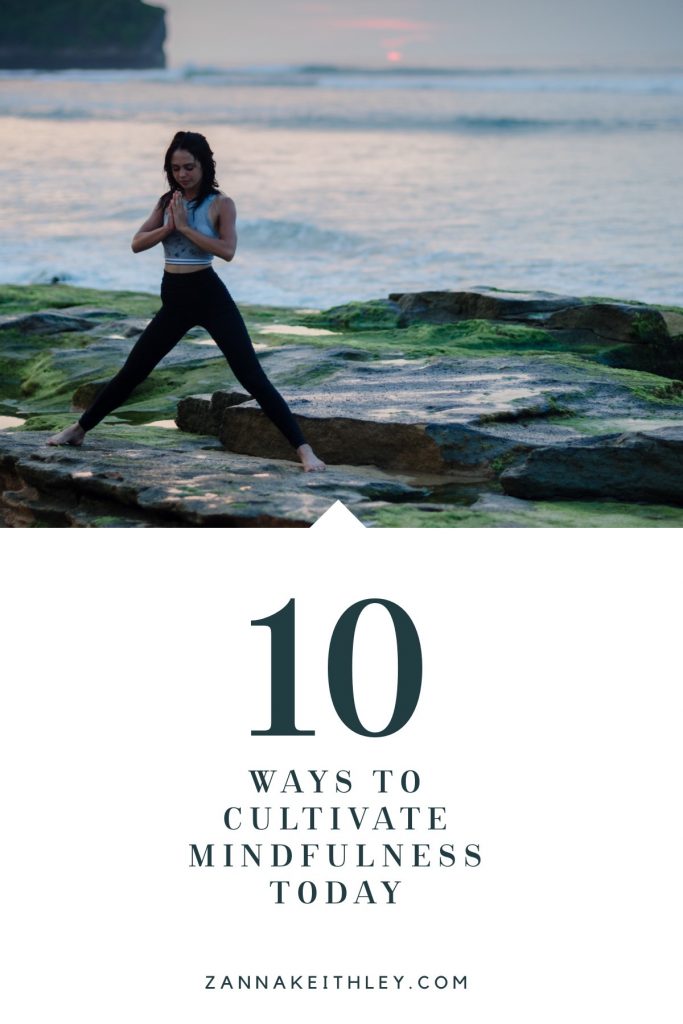
10 Ways to Cultivate Mindfulness Today What is Mindfulness?
In my recent blog post, What is Mindfulness? Plus 15 Powerful Mindfulness Quotes, I gave you my definition of mindfulness, the three components of mindfulness, and a list of powerful quotes from prominent thought leaders on the practice of mindfulness.
To recap, I define mindfulness as non-judgmental, conscious awareness in the present moment.
One of my favorite definitions comes from Jon Kabat-Zinn, the creator of the Stress Reduction Clinic and the Center for Mindfulness in Medicine, Health Care, and Society at the University of Massachusetts Medical School:
“Mindfulness is awareness that arises through paying attention, on purpose, in the present moment, non-judgmentally.”
When we think about mindfulness, it’s likely that the next word that comes to mind is meditation. And while I think meditation has been my most powerful tool in helping me to cultivate mindfulness, you absolutely do not have to meditate in order to live a mindful life.
In fact, anyone can begin a mindfulness practice today, no meditation required. And while you may feel like you’re too busy to start a new mindfulness practice, many of the methods on this list take almost no time at all – just a couple seconds of your conscious thoughts in the present moment.
Below, I’ve written about 10 ways to cultivate mindfulness today. While you definitely don’t have to do all the items on this list, I encourage you to try out as many as possible to see what works for you. To help you out, I listed these in order of practices that take the least amount of time to ones that take the most.
And if you have any questions, don’t forget to post them in the comments below!
Method #1: Phone Notifications/Reminders
The irony isn’t lost on me here. While most of us would say that a little less time on our phones is one of the best ways to cultivate mindfulness, I’m starting out by telling you to spend more time on your phone.
But let me backtrack.
I’m not actually saying to spend more time on your phone; I just think that instead of always focusing on the bad things associated with cell phones, we should focus our attention on the good services they provide.
And one of my favorite ways to use our cell phones for good is to set up positive and uplifting notification reminders that pop up during the day to remind you that you’re doing a great job, that you’re worthy, that you’re capable of doing incredible things – whatever you know you’ll need to hear when you’re in the middle of a chaotic workday.
So how can we use these notifications as a way to cultivate mindfulness?
By setting up reminders to pause in the middle of our day and breathe. These don’t have to be anything dramatic. One of my favorite gentle reminders?
“Breathe.”
Some other reminders you can set up to help you cultivate mindfulness:
- Pause. Breathe. Be.
- Notice your surroundings.
- Pause and look around you. Then, look within.
- Inhale. Exhale.
- Where is your mind right now?
- Where are your thoughts right now?
- Come back to this present moment. Don’t judge. Just be.
At most, these notifications may take a minute or two to set up, but once you have them stored in your phone, you can set them to pop up for you as many times as you want during your day.
Method #2: Post-It Notes
Essentially, post-it notes work in the same way as reminders on your phone, but if you don’t like to look at your phone during the day, this might be a less intrusive method for you. (Or, if you don’t want to choose, do both!)
You can use some of the same reminders I wrote above on your post-its. (Or index cards, scrap pieces of paper, napkins . . . anything you want to write on.) Then, place them in spots you know you’ll see them during the day.
Some suggestions for placement:
- Near your work station
- On your bathroom mirror
- In your wallet
- Near your phone charging station
- Next to the coffee pot
- In your pocket
- Next to the car radio or drink holders
The most important thing with the post-it method is not to get so used to them being there that you ignore them. Set the intention to read the post-its when you see them. Switching out the message weekly and/or using bright colors might help with this.
Method #3: Set Daily Intentions
One way to cultivate mindfulness is to set the intention to practice mindfulness throughout the day. I’m big on having a morning routine (more on that below!), but if you don’t have time for a longer routine, spend just one to two minutes every morning setting a purposeful intention.
Now, this intention doesn’t have to just be, “I will practice mindfulness today.“
To mix it up, you can focus on some of the different components of mindfulness each day.
Here are some examples of daily mindfulness intentions:
- Today, I set the intention to practice non-judgment.
- I will step back from my work once an hour to take three deep breaths.
- Today, I pledge to live in the present moment. When I find my mind wandering to the past or future, I’ll gently bring it back to right now.
- I will observe my internal world with objective awareness.
- I will observe my external world with objective awareness.
Again, the key here is to come back to your intention throughout the day. As you start this practice, phone reminders or post-it notes might benefit you. Or, if you have a whiteboard in or near your work space, you can simply write on it, “Remember your intention.” Let those words bring you back to the present moment.
Method #4: Follow Social Media Accounts that Teach, Discuss, and Encourage Mindfulness
Yes, I know.
Social media is just as bad as phones.
But again, I think we can use social media in this instance for good, not evil.
Do you have Instagram? Twitter? Facebook? Do you find yourself checking your social media once, twice, three times or more a day?
While social media detoxes are good for all of us every once in a while, we don’t have to cancel all of our accounts in order to practice mindfulness.
There are a lot of really amazing people on social media talking about mindfulness every day. These people are using their platform to teach and share their knowledge and experiences.
So let’s let them teach us.
We often open our social media apps on autopilot, not thinking twice about what we’re doing, so a powerful practice is to be mindful every time we open up one of our social media accounts. Notice (with objective awareness . . . no judgment) when you’re clicking that little square on your phone. Are you bored? Sad? Avoiding bad or negative feelings? Again, don’t judge yourself here. Just notice.
Then, when you have that account open, add accounts to your feed that talk about mindfulness. This doesn’t mean you have to unfollow your friends or favorite celebrities. Just find a few accounts that speak to you (you can search the hashtag #mindfulness and go through some of the popular pins to get started), and follow them. Every time you open your app, make sure you read through their images and captions.*
I know this one might sound silly or stupid to some, but I think there’s power in seeing examples, thoughts, ideas, and definitions about mindfulness every day.
My Mini-Disclaimer
*To be clear, I very much believe in listening to what other people have to say about a subject and then forming your own opinions and truth. If you follow a mindfulness blogger who says something that doesn’t feel right to you, question it. You don’t have to blindly accept anything that anybody (including me) tells you, especially if it doesn’t feel right.
Method #5: Breathing Exercises
Not sure if you want to start a meditation practice? Or you already do meditate, but you want to enhance your practice? Breathing exercises are a perfect tool to increase mindfulness, and the best part is you can do them anytime and anywhere.
While there are many variations of breathing exercises, your practice can be simple and straightforward.
For example, breathing from your belly, inhale for four seconds. Hold your breath at the top for another four seconds. Then exhale for four seconds. If you’re comfortable, you can try a variation of this, where you inhale for four seconds, hold your breath at the top for seven seconds, then exhale for eight seconds. You can breathe through your nose or mouth, whatever is most comfortable for you.
Even if all you can do is take a couple seconds for a few slow, conscious inhales and exhales, that’s okay.
The key to using breathing exercises to cultivate mindfulness is to focus on your breathing, grounding yourself in this present moment. And when we are continually able to return to the present moment, we allow mindfulness into our experience.
Method #6: Lean Into Frustrating Moments
This one is tough, but if you stick with it, it can be the most worthwhile.
It’s likely that nearly every day, you encounter experiences that cause you to feel annoyed, frustrated, and maybe even a little angry. Your heart rate increases. You feel a tightness in your chest. Or maybe it feels more like heat pulsating through your veins. Whatever it is, it’s uncomfortable and you don’t like it very much.
To cultivate mindfulness, don’t suppress or pretend these moments don’t exist.
Instead, lean in.
I’m not saying, “Let yourself get so angry and upset that the negative energy overcomes your entire body.”
What I’m saying is this: get curious.
To start, set an intention to recognize your moments of discomfort and/or frustration throughout the day. If you already know that your morning commute is going to make you want to smack your head against the steering wheel, decide to approach the commute a little differently today.
Now, you’re stuck in traffic. The cars aren’t moving. Or maybe someone cut you off. To be clear, you definitely don’t have to like these moments. Allow yourself to feel whatever emotions are rising within you.
And then, simply notice.
Now get curious. Ask yourself questions: Why am I frustrated right now? Why does this experience cause me to feel this way? What do I see in my surroundings right now? What would I change if I could?
Become an objective observe of yourself. That means no judgment. Just notice, probe, observe. Let yourself stay grounded in this present moment.
Now, see if you can do the same thing tomorrow. And the day after that. And then see if you might be able to have this same mindset when an unexpected frustration pops up during your day.
It won’t happen overnight, but if you do this consistently day after day, with time, you’ll see a shift in your mindset and how you view your present experience.
Method #7: Get Outdoors
I can’t quantify how much time this will take during your day. It may take seconds. Maybe minutes. Maybe an hour or more. But if you can make time for 15 minutes to go outside, you’ll experience huge benefits to your mindfulness.
Let’s say you have a 15-minute break during work, and you choose to step outside and take a walk during that time. Or maybe you decide to take a short walk outdoors after dinner. Whenever you can fit in this time, set the intention to stay in the present moment as you walk.
Now, as you’re walking, notice your surroundings. Take note of what you see and hear. How does the air feel on your skin? What sensations do you feel in your body? Is there tension in your muscles? Tightness in your chest? How do your feet feel in your shoes, walking against the ground?
Whatever your answers are, don’t judge. There is no right or wrong, no good or bad. And when you realize your mind has drifted away from the present moment, gently bring it back to right now.
The goal here isn’t to keep your mind from drifting.
The goal is to notice when your mind has strayed and to gently return it back to the present, over and over again.
If walking isn’t your thing, you can also perform this mindfulness exercise when gardening, mowing the lawn, or raking leaves. If the weather permits, you might also choose to do it while stretching outside.
And finally, whatever you decide to do, remember to breathe. Anytime your mind strays, remember that you can always return to the breath.
Method #8: Establish a Morning Routine
Depending on your available time, these last three practices can take anywhere from five minutes to an hour. (And you might also be able to combine them with other practices on this list.)
I’m a big proponent of having a morning routine that isn’t just about hurrying to rush out the door. Personally, I like to journal for 30 minutes first thing after I wake up. I do this when the house is quiet and it’s still dark outside. For me, this is my time to write, create, reflect, and uncover my own feelings, ideas, and thoughts. I also usually work out in the morning, either by running, HIIT exercises, yoga, or light stretching on recovery days.
So how exactly does any of this cultivate mindfulness?
A couple ways.
For one, you might choose to add specific mindfulness practices to your morning routine. You might choose mindful journaling, which entails writing about your thoughts, surroundings, and present experience with objective awareness. You can also add other practices on this list, like daily intention setting and breathwork.
I believe there’s also something powerful about having an intentional and conscious morning routine, no matter what it entails. It means that instead of just unconsciously going through the motions, you’re choosing how you greet the day. And when you start the day by consciously choosing your experiences, you’re more likely to continue this practice throughout the day.
Morning Routine Template
Below is the morning routine template I created for my post, How to Design a Morning Routine for Manifestation. If you don’t have time for journaling, utilizing a template such as this one is a powerful way to set your intentions for the day.
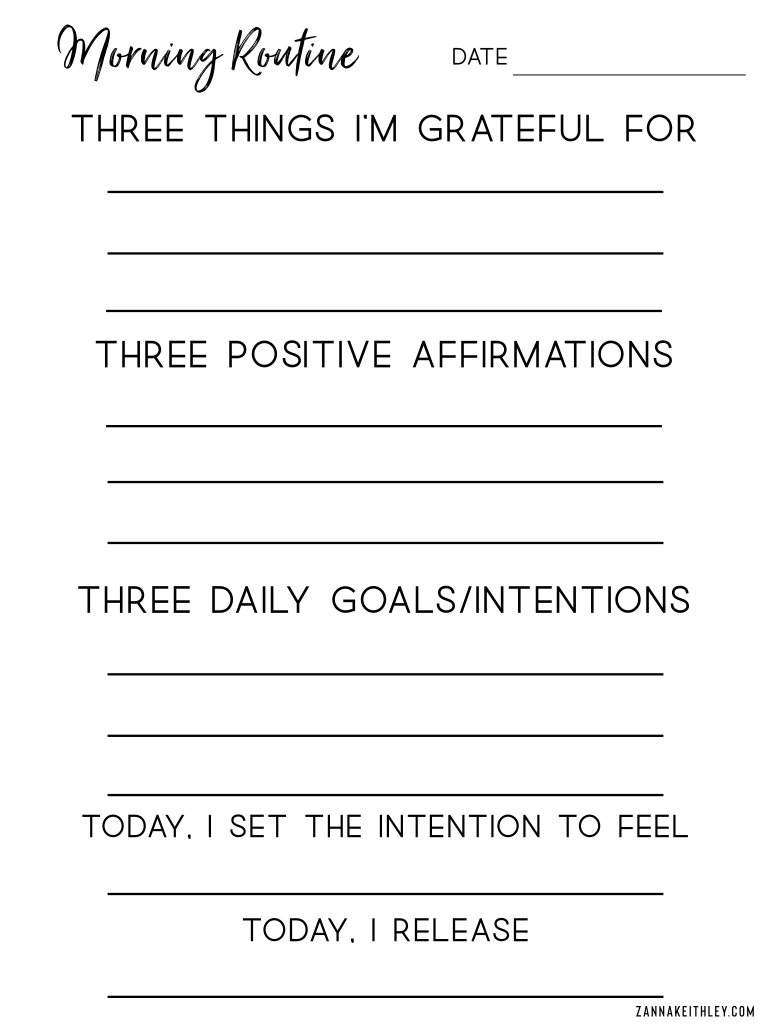
Morning Routine Template Possible Components of Your Morning Routine
- Journaling
- Meditation
- Yoga
- Intention Setting
- Daily Affirmations
- Breathwork
- Reading
- Exercise
- Morning Walk
- Gratitude Practice
Method #9: Meditation
If you’re looking to start a mindfulness practice, it’s hard to find anything that will serve you better than meditation.
First, let’s dig into some myths about meditation.
Meditation is not “clearing your mind of all thoughts.”
And “not thinking” is not the goal of meditation.
Rather, in meditation – mindfulness meditation, specifically – one simply breathes in the present moment, notices when they have a thought with objective awareness, and gently releases it, returning to the present moment.
For instance, imagine you’re laying on the ground looking up at a perfectly blue sky, and a cloud passes above you. “Look, there’s a cloud,” you think. Then it floats out of your vision, and you let it go without attachment.
These clouds are your thoughts. Notice. Release. Come back to the present, over and over again.
If you’ve never meditated before, starting a meditation practice may seem overwhelming at first. To help, I’ve created 7 Meditation Practices for Beginners, which gives you suggestions for how to start as well as links to guided meditations using the Insight Timer app. (No affiliation.)
Just know that even if someone on a podcast says they meditate for two hours a day, or an Instagram influencer swears by meditating for twenty minutes twice a day, you don’t have to start big. When I started meditating, I pledged just ten minutes a day. Sometimes, five. And even now, I often meditate for no more than ten to fifteen minutes.
You can definitely cultivate mindfulness without meditation. The walking exercise I described in the “Get Outdoors” section is a great way to start. But I believe meditation has been my greatest teacher in cultivating mindfulness. If you’re open to it, pledge to meditate for ten minutes a day, ten days in a row. Start small, then see how you feel after that.
Method #10: Yoga
Yoga is another powerful practice that may take ten minutes, an hour, or somewhere in-between. If you’ve never tried yoga before, this one might be even more intimidating than meditation. So let’s make it a little less intimidating by talking about why yoga cultivates mindfulness and how to gently step into a new yoga practice.
First, like we did with meditation, let’s debunk a myth about yoga:
Yoga isn’t about getting into a pose and holding it as long as possible until you can no longer stand the pain.
The beauty of yoga (in my experience, at least) is in the flow: the gentle awareness of the energy flowing through my body. Yoga is when my mind and body become one, and I simply exist in this present moment. The greatest lesson I’ve learned from yoga isn’t to become more flexible; it’s to become one with my breath.
Yoga cultivates mindfulness because it allows us to be in this present moment, at one with our breath, simply noticing the sensations and feelings in our body with non-judgmental awareness.
If starting a yoga practice seems intimidating, YouTube might become your new best friend. There are thousands of videos online dedicated to beginner’s yoga. If you’re not sure where to start, I highly recommend Yoga With Adriene’s Foundations of Yoga series. This series is comprised of 45 separate five to twenty-five minute videos, each dedicated to helping you explore a different yoga pose. I love these because you can take your time with each pose and go at your own pace.
If you want to learn a little more about yoga and mindfulness, here and here are a couple articles that dive a little deeper into the connection between your body and your mind.
And there you have it: ten ways to cultivate mindfulness today. Remember that you don’t have to include all ten practices into your life today. Start small. Choose a few that feel right to you. And if one of those methods doesn’t click, choose again. And remember that every moment in our lives provides us with an opportunity to practice mindfulness. Even right now. Notice the thoughts, sounds, sensations, and feeling of the present moment. No judgments. Just observe.
Other Posts You Might Like
- 10 Science-Backed Health Benefits of Meditation
- A Beginner’s Guide to Understanding and Unblocking Your Chakras
- 25 Epic Morning Affirmations to Create a Beautiful Day

10 Ways to Cultivate Mindfulness Today 
Zanna Keithley is an author, poet, and social media content creator who writes short prose dedicated to inspiring readers to follow their dreams, trust their intuition, and create beautiful and fulfilling lives. You can find her original writing on Instagram @zannakeithley.
-
What is Mindfulness? Plus 15 Powerful Quotes
In this post, I’ll go in-depth on the three components of mindfulness, plus provide you with 15 life-changing quotes about mindfulness that will change the way you think. Be sure to check up my follow-up post, 10 Ways to Cultivate Mindfulness Today, where I provide you with ten simple and effective practices you can do today to cultivate a more mindful life.
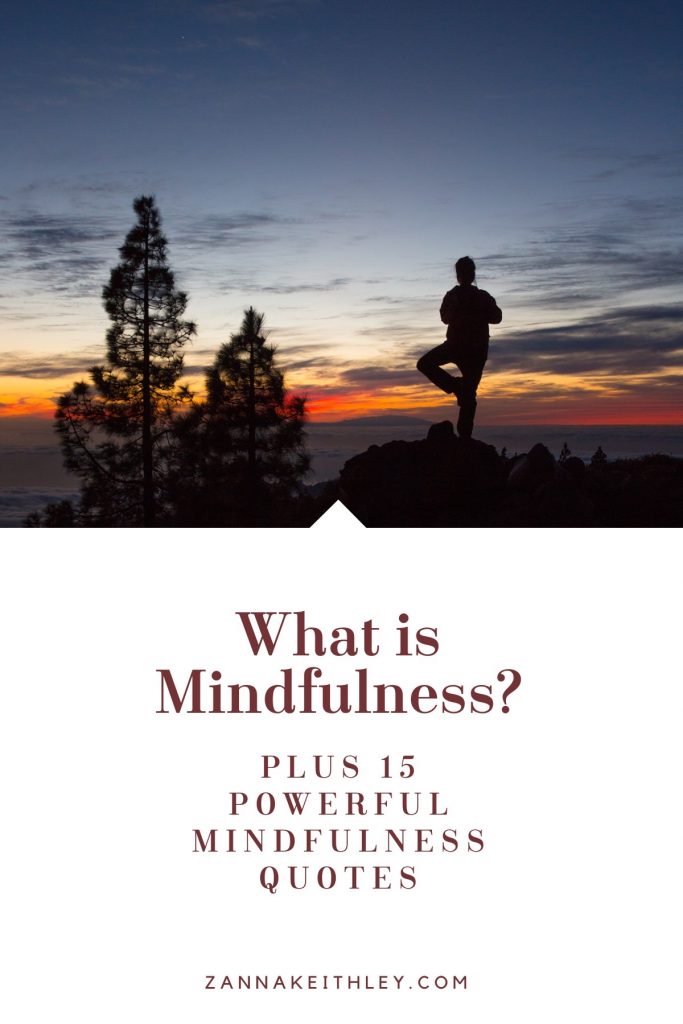
What is Mindfulness? Plus 15 Powerful Quotes Mindfulness
This word has been gaining recognition and popularity over the past several years (for good reason), becoming more than just a concept reserved only for experienced meditators and skillful yogis. From mindfulness coaches to mindfulness bloggers (*raises hand*), we see reminders to be mindful all over social media, blogs, and news sites.
But what exactly does this mean?
I’ll be the first to admit that when I first heard the term mindfulness, I had no idea what it was actually referring to. From what I knew of the word mindful, I had some guesses: it probably had something to do with awareness and maybe having respect for yourself and others, such as to be mindful of your words or to stay mindful of somebody’s personal space. That didn’t seem too difficult. From that fuzzy and uncertain definition, I was pretty sure I already had a solid foundation in mindfulness already built up for myself.
Spoiler alert: I was wrong.
I’m not sure I ever actually sought out an actual definition of mindfulness. Rather, the practice found me, and as I opened myself up and made space for it in my life, more resources and guidance came to me to help me in my journey.
While meditation has been my greatest teacher in helping me discover mindfulness, you absolutely do not have to meditate to cultivate mindfulness. We begin cultivating mindfulness the moment we return our awareness to this present moment (and when our minds inevitably stray, gently bringing it back to the now, over and over again).
In this post, I’ll break down what mindfulness really means, including its three core components, as well as give you fifteen powerful quotes from past and present thinkers and visionaries on what mindfulness is, what it does, and why it’s important.
What Is Mindfulness?
This morning, as I was applying my makeup, I noticed that I chose the exact same eyeshadow from my eyeshadow palette that I’ve been unconsciously choosing for probably a week straight. I pointed my brush right at the little rectangle and dipped it into the neutral, beige-ish powder without even thinking about it, probably just as I had yesterday and the day before. Today, though, I paused for a second. Then I looked at the other colors on the palette. I recognized what I was doing, made the conscious decision to keep using that same eyeshadow again, and then applied my eyeshadow.
As small and seemingly inconsequential as this moment was, this is an example of mindfulness.
We all have unconscious behaviors we engage in every single day. And that’s okay! We don’t need to fight or avoid these unconscious behaviors. To be honest, it’s kind of nice to go on autopilot every once in a while and perform actions that don’t take tons of thought.
Mindfulness is, in many ways, the art of noticing. In my example, choosing the same eyeshadow color I’ve been picking for the past week was an act of simply noticing. I was able to pause in the middle of my unconscious act and simply observe myself.
Going Beyond Just Noticing
Now, if we deepen our definition of mindfulness, we see it as a little more than just noticing: it’s non-judgmental awareness in the present moment.
Here are two reactions I could’ve had when I noticed that I picked the same eyeshadow color for the umpteenth time:
- “Good God, Zanna, what is wrong with you? You should’ve been paying better attention. You’re not mindful. You’re just going through the motions again!”
- “Huh. That’s interesting.”
Mindfulness does not mean you notice and then berate, bully, and judge yourself for your thoughts and actions.
Mindfulness means you notice and observe without any judgment.
(But if you realize that you are judging yourself, that’s okay. This is my absolutely favorite thing about mindfulness: we can stray as many times as we want and always come home to ourselves. So if I had chosen that first reaction above, I could’ve observed my own judgment and then thought, “Huh. Okay. I’m judging myself. That doesn’t align with who I am. I think I’ll choose again.” The important thing is not to let this become a domino effect. If you notice yourself judging, try not to judge yourself for judging. Instead, choose again. Choose differently. Be gentle with yourself. Just the act of recognizing and choosing again is going to be of far greater service to you in your journey than being a perfect mindfulness student all of the time.)
Defining Mindfulness
My favorite descriptor for our individual roles in a mindfulness practice is to be an objective observer. This means I have the power to step outside of myself in the present moment and notice my thoughts and actions without judgment or criticism. And when I see that my thoughts are returning to stories of the past or future, I can gently guide myself back to this moment right now. And I can do that again and again and again, as many times as I need.
So here’s my personal definition of mindfulness:
Mindfulness is non-judgmental, conscious awareness in the present moment.
And to be mindful is to be an objective observer of oneself.
And that’s it. Of course, we can continue to dive deeper as we explore and discuss mindfulness, but for a definition, it’s truly that simple.
The 3 Components of Mindfulness
So from my definition above, we can break down the concept of mindfulness into three components:
- Conscious Awareness: To recognize your thoughts, words, and actions as you’re thinking, speaking, and acting. This is the opposite of the “autopilot” mode we all fall into once in a while. Conscious awareness is taking a step back, recognizing the autopilot mode, and choosing how you think and feel in this moment.
- Lack of Judgment: Autopilot mode is normal. So is letting our minds wander to the past or future. So is anger, fear, sadness, pain, anxiety, worry, boredom, and all kinds of emotions that we label as good or bad. The key to mindfulness is to not judge ourselves for our thoughts and emotions. Simply notice. Observe. Choose again.
- Returning to the Present Moment: I think about the past a lot. I also think about the future a lot. And that’s okay. I can also recognize that the only real thing in the world is this moment right now. We can think about the past and future, but don’t live there. Live in this moment. That’s what mindfulness does for us; it allows us to honor and recognize the beauty, value, and importance of this moment right now.
15 Powerful Quotes
“Mindfulness is simply being aware of what is happening right now without wishing it were different; enjoying the pleasant without holding on when it changes (which it will); being with the unpleasant without fearing it will always be this way (which it won’t).” – James Baraz
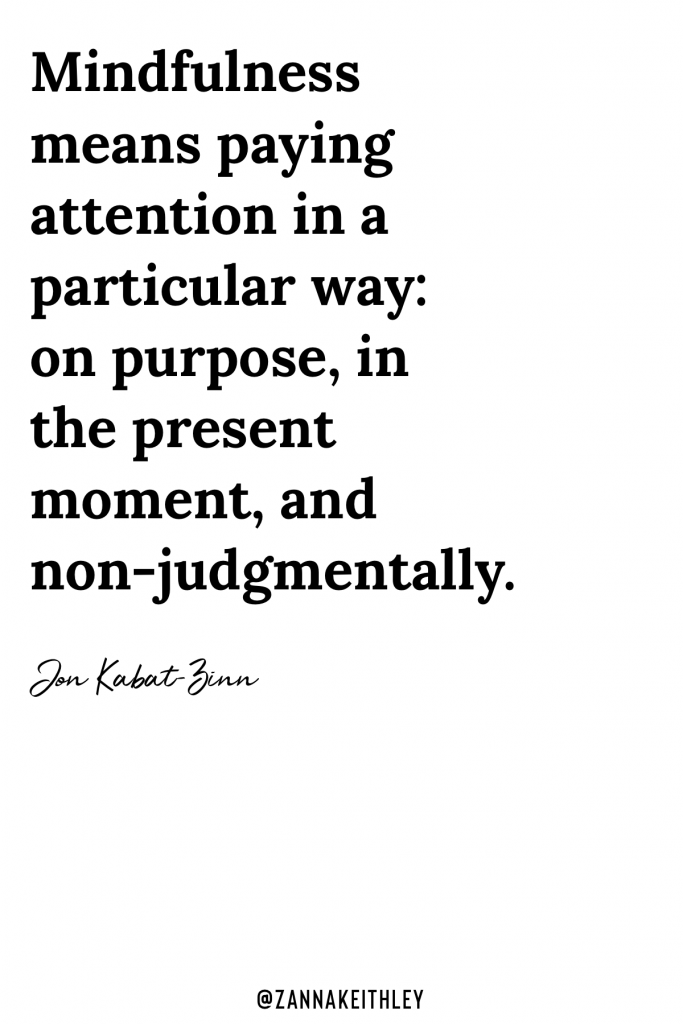
Jon Kabat-Zinn Mindfulness Quote “What would if be like if I could accept life – accept this moment- exactly as it is?” – Tara Brach
“That’s life: starting over, one breath at a time.” – Sharon Salzberg
“If you want to conquer the anxiety of life, live in the moment, live in the breath.” – Amit Ray
“Wherever you are, be there totally.” – Eckhart Tolle
“Feelings come and go like clouds in a windy sky. Conscious breathing is my anchor.” – Thích Nhất Hạnh
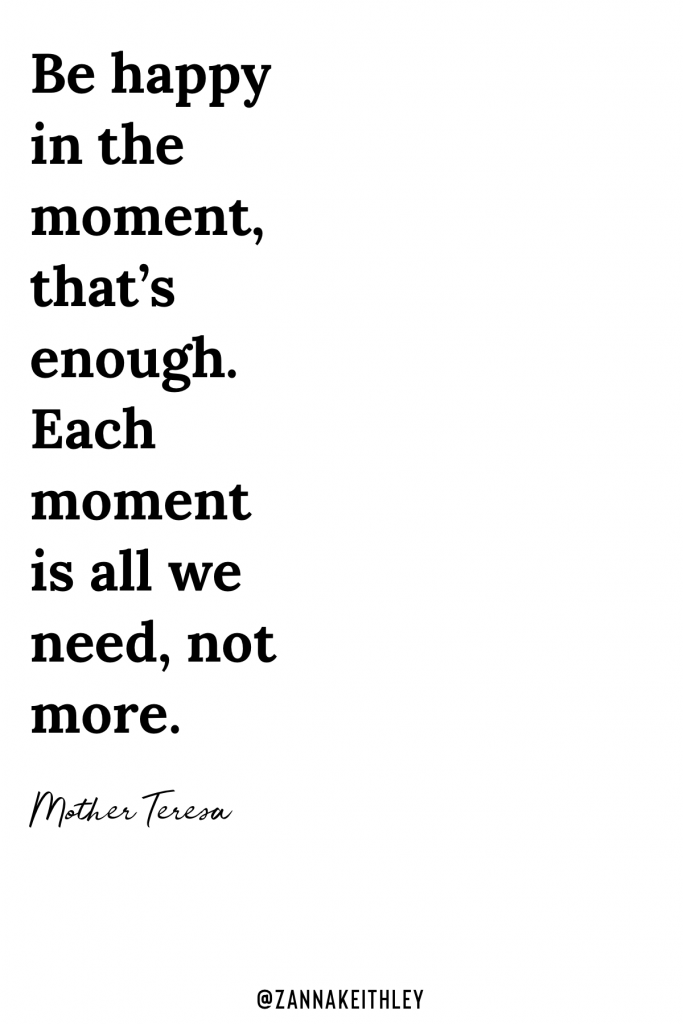
Mother Teresa Mindfulness Quote “Mindfulness is the aware, balanced acceptance of the present experience. It isn’t more complicated than that. It is opening to or receiving the present moment, pleasant or unpleasant, just as it is, without either clinging to it or rejecting it.” – Sylvia Boorstein
“Pure awareness transcends thinking. It allows you to step outside the chattering negative self-talk and your reactive impulses and emotions. It allows you to look at the world once again with open eyes. And when you do so, a sense of wonder and quiet contentment begins to reappear in your life.” – Mark Williams
“We spend a lot of time judging ourselves harshly for feelings that we had no role in summoning. The only thing you can control is how you handle it.” – Dan Harris
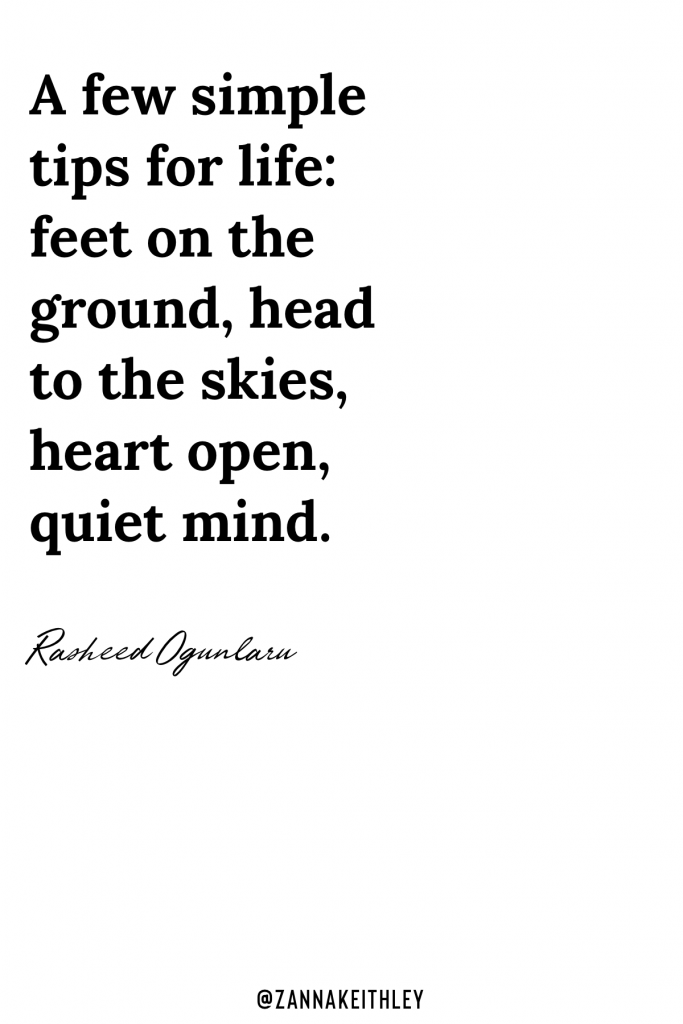
Rasheed Ogunlaru Mindfulness Quote “Whatever state I am in, I see it as a state of mind to be accepted as it is.” – Nisargadatta Maharaj
“Learn to slow down. Get lost intentionally. Observe how you judge both yourself and those around you.” – Tim Ferriss
“Don’t believe everything you think. Thoughts are just that – thoughts.”- Allan Lokos
Want to Learn More About Mindfulness?
Check out these awesome resources!
- mindful.org
- UMass Memorial Health Care Center for Mindfulness
- Awakening Joy
- Short animated video by Happify: Why Mindfulness is a Superpower
If you’re thinking about starting a meditation routine but aren’t sure where to begin, be sure to check out my post, 7 Types of Meditation Practices for Beginners. And if you have any questions about mindfulness or meditation, leave a comment below or connect on social media! I’d love to hear from you!

What is Mindfulness? Plus 15 Powerful Mindfulness Quotes 
Zanna Keithley is an author, poet, and social media content creator who writes short prose dedicated to inspiring readers to follow their dreams, trust their intuition, and create beautiful and fulfilling lives. You can find her original writing on Instagram @zannakeithley.
-
Chakras for Beginners: Unblock Your Chakras Today
Looking for a guide to understanding chakras for beginners? I’ve got you covered with all the essential details you need to know to start understanding, activating, balancing, and unblocking your body’s important energy centers today.
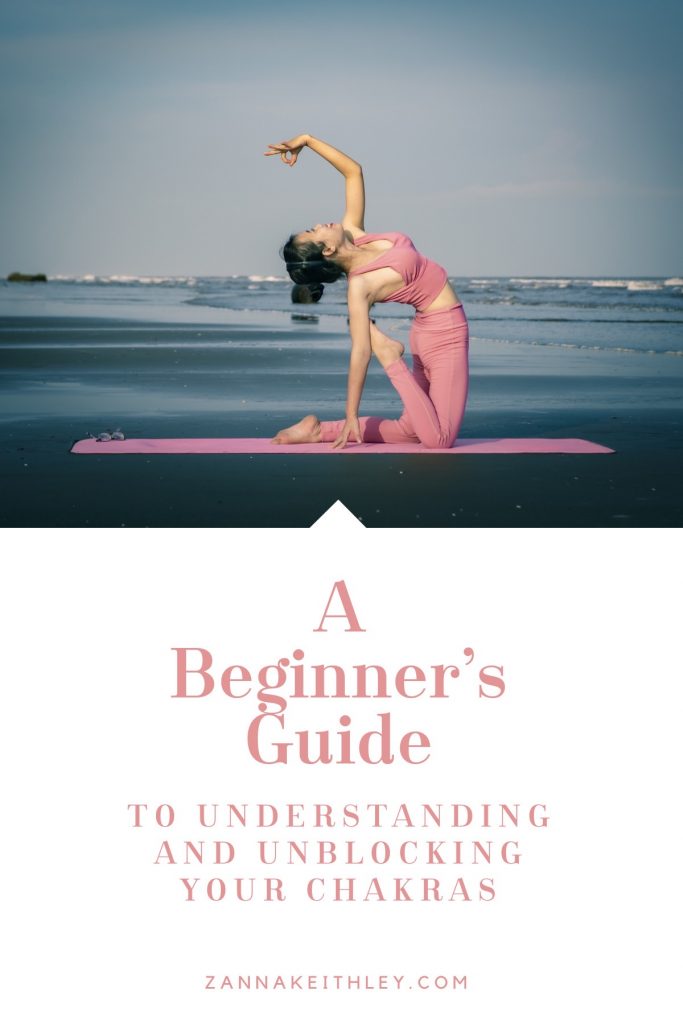
Chakras for Beginners: Unblock Your Chakras Today Discover More About Chakras
Chakras
If you’ve recently started a new meditation or yoga practice, you’ve likely heard the term chakras used by teachers, speakers, and guides. I still remember when I began listening to guided meditations and hearing terms like third eye chakra and crown chakra being used for the first time.
As a meditation beginner, I had a vague, fuzzy idea of what these words meant, but I wasn’t entirely sure on the specifics.
Depending on the teacher’s wording, I wasn’t always sure if my third eye chakra was between my eyes or higher up on my forehead, or if the crown chakra was actually on my head or above my head.
Each chakra has its own intricacies that you’ll want to understand, but before diving into the complexities of the individual chakras, it’s helpful to start with a solid foundation of the basics.
In this post, I provide you with a guide to understanding chakras for beginners. This guide contains a discussion of the seven main chakras and their roles as well as their colors, locations, and other significant details about each energy center.
I also provide you with affirmations related to each chakra, methods to balance and unblock your chakras, and links to some great meditations to help you activate your energy centers.
Chakras for Beginners: Overview
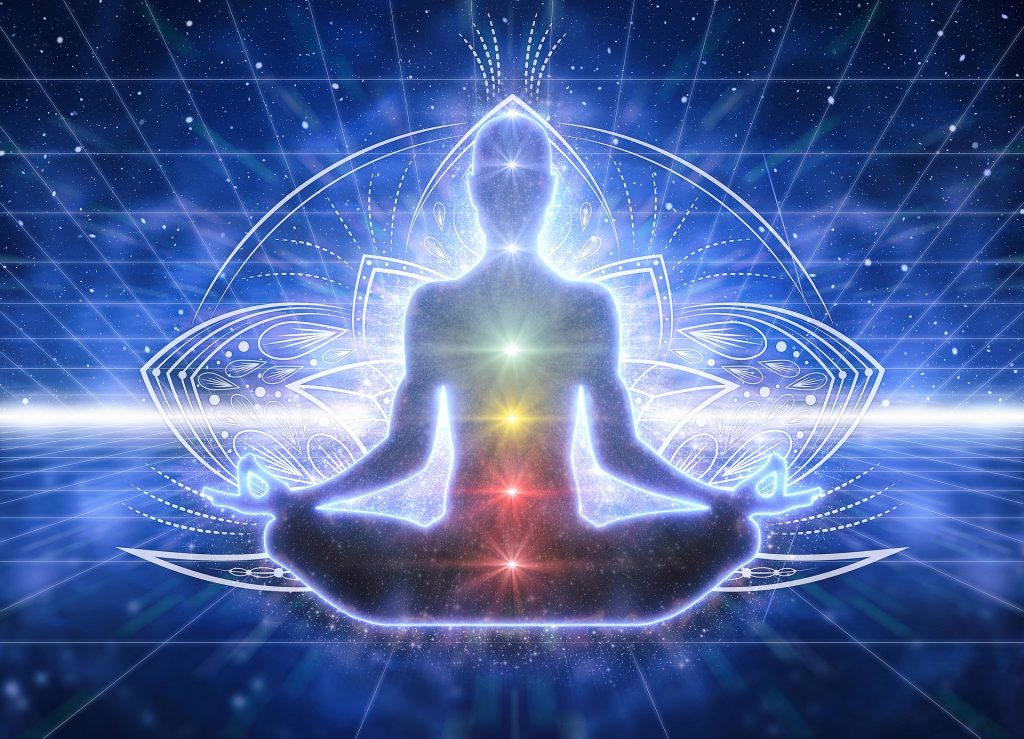
As I mentioned in the intro, there are seven main chakras. Each chakra has its name as well as its Sanskrit name, a specific location in the body, an associated color and symbol, and distinct roles and attributes. (Note that when I say they have specific locations in the body, a chakra is not a physical, tangible thing. Rather, it’s an energy center in the body. More on that in a minute!)
But this isn’t all. Going even deeper, you find that each chakra also has associated foods, gemstones, mantras, body parts, animals, and even essential oils.
But before we get into the details, let’s start with the most fundamental question: what exactly is a chakra?
The word chakra is a Sanskrit word meaning wheel or disk. So when we define what a chakra is, we often go back to this translation: a chakra is a wheel of energy in your body.
Think of it like a vortex of energy within you:


While chakras are often depicted in images as bright, colored light, we can’t actually see these energy centers in our body. Rather, we experience them through feelings and sensations. You might also call it an inner knowing or intuition.
Understanding Chakras: The Flow of Energy
Energy is meant to flow, and ideally, this energy (or prana) is always flowing within you. When our chakras are open, energy is flowing and we feel in alignment with our highest selves.
But when a chakra is blocked, the energy stagnates, and we become misaligned. Often, this manifests in physical, emotional, mental, and/or spiritual blockages. If one chakra is blocked, we may also overcompensate by causing another chakra to become overactive.
For instance, if your root chakra is blocked (your root chakra is associated with helping you feel grounded, steady, and stable), then your solar plexus chakra might become overactive (which could cause you to cling to perfectionistic tendencies and/or a desire for control).
There are seven main chakras that each have their own distinct roles, but it’s important to remember that they act as one whole system. It might help you to think of it like the physical organs inside your body. Even though each organ has a specific role and function, they all work together to keep you in optimum health and alignment. When one organ isn’t functioning correctly, this often negatively affects other parts of your body.
This is the same with chakras: when one chakra is blocked, this affects the energy flowing through our other chakra points.
The 7 Main Chakras & Their Roles
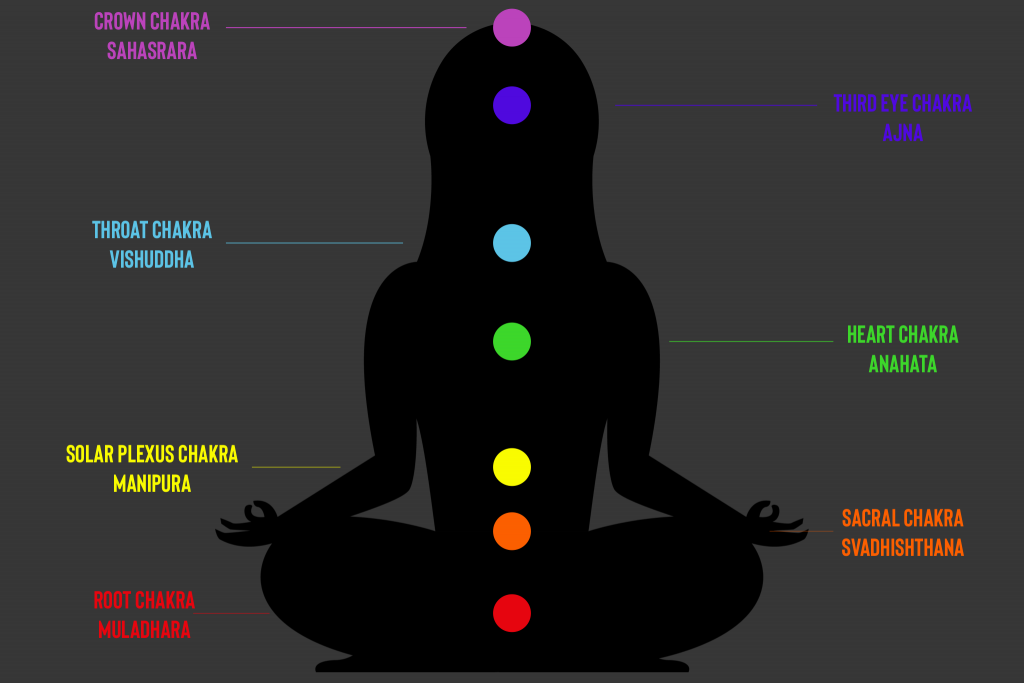
Below is a guide to the seven main chakras and their distinct roles and attributes. You’ll notice that I start with the root chakra and work up through the spine, ending at the crown chakra. If you hear someone refer to first chakra, second chakra, third chakra, and so on, they usually are referring to the root chakra as the first chakra, the sacral chakra as the second, continuing to move upward.
The details below will provide you with a helpful baseline to better understand each chakra as you discover where your energy centers are located and how they function.
Root Chakra
- Sanskrit Name: Muladhara
- Location: Base of the spine
- Color: Red
- Balanced Attributes: Grounded, safe, secure, stable, centered. Like the roots of a tree, this is your foundation. You’re firm in your place in life, and your basic needs are being met.
- Imbalanced Attributes: Anxious, insecure, fearful, excessive negativity, depressed. Energies feel scattered and disorderly. Disconnected and restless.
- Mantra/Sound: LAM
- Gemstones: Onyx, smoky quartz, bloodstone, hematite, obsidian
- Affirmations: I am grounded, centered, and stable. I am rooted and secure. All is really well. I have everything I need. I feel safe in my body.
Sacral Chakra
- Sanskrit Name: Svadhishthana
- Location: Lower abdomen
- Color: Orange
- Balanced Attributes: Creative, joyful, prosperous, sexual, sensual, passionate, energetic.
- Imbalanced Attributes: Withdrawn, tense, insecure, needy, irritable, controlling, manipulative.
- Mantra/Sound: VAM
- Gemstones: Orange calcite, jasper, carnelian, red tiger’s eye
- Affirmations: I am open to the flow of creativity. I am creative, passionate, and inspired. My emotions flow freely in a balanced and healthy way. I live a creative, passionate, healthy life. I deeply respect and honor my sacred body, and I honor my own divine sensuality.
Solar Plexus Chakra
- Sanskrit Name: Manipura
- Location: Stomach/below the chest
- Color: Yellow
- Balanced Attributes: Confident, positive, high sense of self-respect and self-esteem, joyful. This is your source of personal power; you have drive, a positive self image, and feel aligned with your purpose.
- Imbalanced Attributes: Low self-esteem, lack of ambition, lack of purpose, fear of rejection, sensitive to criticism, low energy. If overactive, can also become manipulative, domineering, power-hungry.
- Mantra/Sound: RAM
- Gemstones: Citrine, topaz, yellow tiger’s eye
- Affirmations: I am powerful, strong, and confident. I can achieve anything I set my mind to. Today, I confidently welcome new experiences. I am competent, capable, and strong.
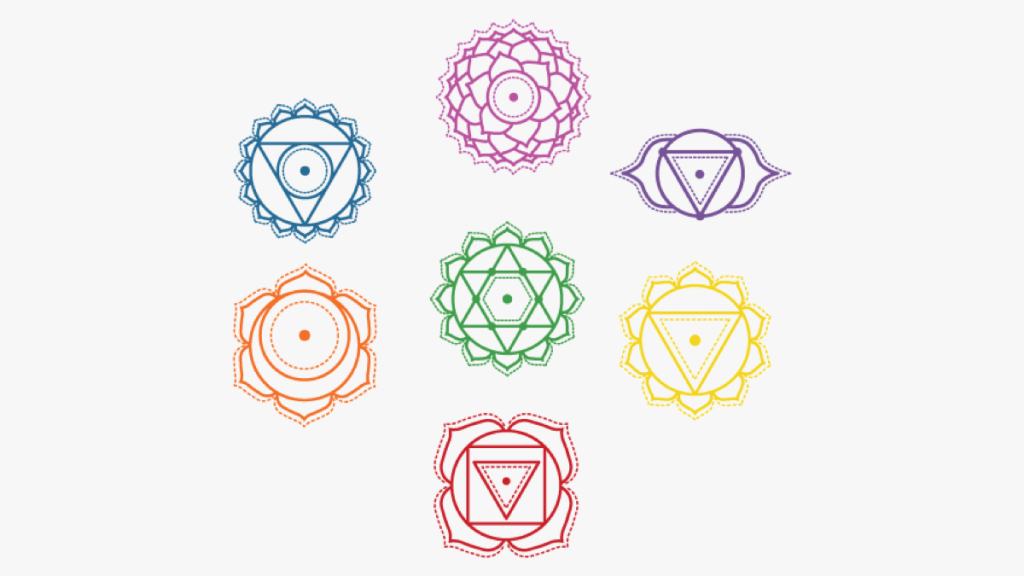
Heart Chakra
- Sanskrit Name: Anahata
- Location: Heart/center of chest
- Color: Green
- Balanced Attributes: Loving, peaceful, compassionate, unconditional love for yourself and others, generous, kind, empathetic.
- Imbalanced Attributes: Depressed, jealous, defensive, judgmental, spiteful. May excessively self-isolate from others. Fearful of intimacy.
- Mantra/Sound: YAM
- Gemstones: Rose quartz, jade, green calcite
- Affirmations: I am loved, loving, and lovable. I love myself unconditionally. My heart is open, loving, and pure. I give and receive love effortlessly and unconditionally. I love and accept myself just as I am.
Throat Chakra
- Sanskrit Name: Vishuddha
- Location: Throat/center of neck
- Color: Light blue
- Balanced Attributes: Able to express yourself verbally and speak your truth. Communicates clearly and effectively. Calm, honest, peaceful.
- Imbalanced Attributes: Shy, withdrawn, dishonest, critical, moody. If overactive, you may interrupt others or not allow others to speak.
- Mantra/Sound: HAM
- Gemstones: Blue lace agate, turquoise, sodalite, aquamarine
- Affirmations: I am able to calmly and effectively speak my truth. I live an honest, authentic, wholehearted life. My voice matters. I express myself clearly and openly. I find creative ways to communicate my self-expression.
Third Eye Chakra
- Sanskrit Name: Ajna
- Location: Center of forehead/between the eyebrows
- Color: Indigo
- Balanced Attributes: Intuitive and connected to your inner knowing. Imaginative, perceptive, openminded, insightful, mentally strong.
- Imbalanced Attributes: Lack of intuition, unimaginative, fearful, unable to focus, close-minded, holding onto limiting beliefs.
- Mantra/Sound: OM or SHAM
- Gemstones: Lapis lazuli, opal, sapphire
- Affirmations: I listen to my inner knowing in the face of uncertainty. I see and think clearly. My mind is strong, open, and clear. I trust my intuition to guide me to making good decisions.
Crown Chakra
- Sanskrit Name: Sahasrara
- Location: Top of the head
- Color: Violet (White is also often associated with this chakra.)
- Balanced Attributes: Spiritual, enlightened, connected to a higher power, connected to oneself. Divine peace and a sense of inner wisdom. Able to surrender to a power higher than oneself. Connected to your soul’s purpose.
- Imbalanced Attributes: Cynical, close-minded, disconnected from yourself, disconnected from a higher power. Lack of faith. Unable to connect with others.
- Mantra/Sound: OM (or silence)
- Gemstones: Selenite, clear quartz, amethyst, diamond.
- Affirmations: I am always divinely and lovingly guided. I release the need to control my life and surrender to a higher power. Today, I trust the path in front of me and allow myself to let go and surrender. I trust my intuition and listen to the wisdom of the universe.
Unblocking and Balancing Your Chakras
Now that you have an understanding of where each chakra is located and their distinct attributes, how exactly do you unblock a chakra?
As you may have guessed, there is no scientific answer here. We all have different methods of unblocking chakras, and what works for one person may not work as well for the other. But at the foundation of these practices, it’s most important to set an intention, lean into the process, commit, and believe.
Also remember that it’s very likely and totally normal to have more than one chakra blocked or unbalanced at a time. While each chakra has a separate location and role, they’re all intertwined and function as one complete system.
Consider this example: If your root chakra is blocked, you may be feeling unstable, insecure, restless, and possibly even unsafe. The root chakra is your very foundation, and without it being open, it would be nearly impossible to feel creative and joyful (sacral chakra) or confident and positive (solar plexus chakra).
Below is a list of several ways you can start balancing your chakras today.
Methods of Balancing Your Chakras
Yoga
There are specific yoga poses associated with each chakra, such as the mountain pose for the root chakra or child’s pose for the third eye. If you want to focus on balancing a specific chakra, you can center your practice on only those poses associated with that chakra. For a more balanced practice, incorporate poses that include all of the chakra points. If you’d like, you can also begin or end your practice repeating the mantra for one of the chakra points. (See the list of Chakras above for each one’s associated mantra/sound.)
Meditation
There are several ways meditation can help with unblocking chakras. You can use a visualization meditation to visualize the energy centers (in each chakra’s corresponding color) brightening, swirling, and glowing. You can also do a mantra meditation in which you repeat the mantras associated with each chakra to clear any blockages and imbalances. See the next section for some links to some powerful guided chakra meditations!
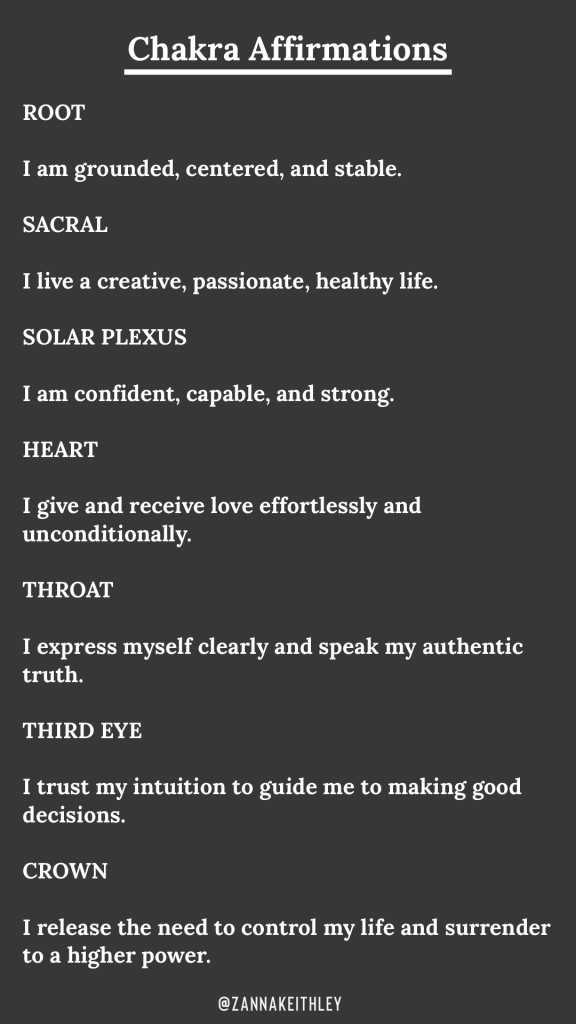
Chakra Affirmations Repeat Affirmations
You can use the affirmations I’ve written for each chakra above or come up with your own powerful affirmations. One of the best things about affirmations is that you can recite them anywhere. Repeat them in the shower, during your morning commute, or even standing in line in the grocery store. You can also combine affirmation practices with other methods on this list, such as meditation, journaling, and even dancing!
Essential Oils
Each chakra is associated with various essential oils that can help calm or stimulate that specific energy center. For instance, you might use cedarwood for your root chakra, lemon for the solar plexus, or peppermint for the throat. To use essential oils to help balance your chakras, apply a small amount of the oil to the chakra point. (While essential oils are generally safe, I would definitely recommend making sure you use a high-quality brand and following the guidelines of the manufacturer before applying anything to your skin. Depending on the type, some oils may require dilution. Definitely do your research and follow up with a health expert if you have any questions before applying.)
Colors
Solar plexus chakra feeling blocked? Wear yellow. Eat a banana. Paint with the color yellow. Make your own homemade lemonade. Find all the yellow items in your home and put them in your line of sight.
Journal
One of my favorite practices is to combine affirmations into my journaling. If you have 10 to 30 minutes to sit down for journaling, write down affirmations that focus on one, multiple, or all of your chakras. Another great practice is to visualize and describe your highest, truest, and most authentic self – the highest version of you when all of your chakras are aligned. The key here is to write in the present tense! Instead of writing, “I see myself as . . .” or “I will be . . .”, write, “I am . . .” Embody that version of your highest self and become that person as you write.
Dance
Dancing is a beautiful way to express yourself and enhance the flow of energy in your body. If you can, try to involve the body part related to any blocked chakras into your dance. For instance, if your heart chakra feels blocked, incorporate more chest movements into your dancing. You can also incorporate colors here as well! Remember to have fun, don’t take yourself too seriously, and surrender to the flow!
Immerse Yourself in Nature
Walk barefoot in the dirt (root chakra, associated with the earth; go swimming (sacral chakra, associated with water); have a (safe) bonfire (solar plexus chakra, associated with fire); take a cleansing walk as you focus on breathing in the fresh air (heart chakra, associated with air). If multiple chakras feel blocked, getting back to your foundations (nature and the earth) is one of the best ways to clear any blockages.
Food
Eat a food associated with the color of the chakra (i.e. a red apple, green spinach, orange carrot). Try to aim for something healthy, unprocessed, and nutrient-dense.
Crystals
You can use crystals associated with each chakra to activate that energy center. Some simple practices are to hold the crystal over the chakra point for three to five minutes, lay the crystal on the body for an extended amount of time, or to meditate with the crystal by either holding it or laying it on the body (if you’re laying down). If you want, you can even place all seven crystals on each chakra point at once while you’re laying down.
Express Your Creativity
Embrace ways to express your creativity, such as drawing, painting, dancing, singing, working with clay, writing poetry, or however you like to unleash your inner creative!
Chakra Meditations
The following meditations can all be found on the Insight Timer app (no affiliation). This is a free app that offers over 55,000 meditations and music tracks (all completely free). You can read more about why I choose this app as well as learn about different meditation practices for beginners here.
- Chakra Waterfall Meditation by Jessie Arielle Smith (6 minutes)
- Chakra Balancing by Kiran Chugani (8 minutes)
- Personal Transformation: Energy Centers Chakra Discovery by Dexter and Alessandrina (12 minutes)
- Guided Chakra Healing Meditation by Healing Haus (19 minutes)
- Sacral Chakra Therapy by Cory Cochiolo (19 minutes)
- Chakra Tune-Up by Gemma Clarke (21 minutes)
And that’s a a guide to chakras for beginners! Be sure to check the links at the top of this post to learn more about the individual chakras. Have any questions about chakras? Or have you discovered any practices that have helped you activate and balance your chakras? Leave a comment below to ask a question or share your experiences!

Chakras for Beginners: Unblock Your Chakras Today 
Zanna Keithley is an author, poet, and social media content creator who writes short prose dedicated to inspiring readers to follow their dreams, trust their intuition, and create beautiful and fulfilling lives. You can find her original writing on Instagram @zannakeithley.
-
10 Science-Backed Health Benefits of Meditation
If you’re thinking about starting a meditation practice or interested in finding out how your current practice is benefitting you, read below for the science on 10 of the most significant health benefits of meditation.

Pin this for later! 10 Science-Backed Health Benefits of Meditation Meditation
When I decided to try meditating for the first time, I was skeptical. Like many others, I was filled with doubts about whether I was even capable of meditating.
No way can I empty my brain of thoughts.
I’ll try it, but I’m not actually going to be good at it.
So I’m just supposed to do . . . nothing?
But through my meditation journey, I’ve learned that the goal of meditation isn’t to empty my brain of thoughts; the goal of meditation (mindfulness meditation, specifically) is to recognize (without judgment) when my thoughts have strayed and gently return to this present moment, over and over again.
Through this practice, I have learned how to become an objective observer of myself.
Which is a pretty big deal, after spending most of my life being a brutal self-critic.
To transform my default thoughts from inner bully to non-judgmental onlooker has been, well, pretty incredible.
In fact, these days, when I step out of my objective observer role, it’s to bring out my inner cheerleader. You see, most of my thoughts about myself now revolve around my own inherent worthiness. I now know I’m capable and deserving of living most honest and beautiful life I envision for myself.
I never imagined this path for myself when I reluctantly meditated for the first time several years ago.
However, I know that emphatic claims from family, friends, bloggers, and Instagram influencers can only go so far. Most of us need proof that meditation is so much more than just 10 minutes of sitting in silence.
That’s where the science comes in.
When I decided to tackle this subject, I had no idea what I’d find. Are there actually legitimate studies on the science-backed health benefits of meditation?
Yes, it turns out. Lots of them.
To say that I was blown away by the results would be an understatement; there are 1000s of studies and articles out there on the subject. (If you type “meditation benefits” in Google Scholar, you’ll get nearly 600,000 results.)
Below, I’ve compiled a list of 10 of the most compelling science-based health benefits of meditation.* These benefits come from multiple peer-reviewed studies and scholarly articles, and I’ve included links if you want to read deeper into each benefit.
*Please note that this content is for informational purposes only. It is not meant to substitute for medical advice, diagnosis, or treatment. If you have any questions regarding meditation and your personal health, please consult your doctor.
Health Benefit #1: Decreases Stress
This is a big one, and I list it first because decreased stress itself results in so many positive health benefits: improvements to your immune system, sleep quality, and weight management, to name a few.
First, I actually want to take a step back for a moment and say this: a little bit of stress in our lives isn’t actually such a bad thing.
Not that long ago, stress prompted our ancestors to run from the saber-toothed tigers. And now in our current world, stress propels us to swerve out of the way from that ongoing car. At its foundation, stress is meant to keep us alive.
But our bodies aren’t wired for the persistent stress we encounter today in work and our personal lives. And that’s why stress has become synonymous with a four-letter word in western culture.
But meditation can help.
Numerous studies have produced findings showing that meditation has a positive impact on a person’s stress levels.1 2 3 Studies even show that the use of a meditation app on your smartphone can significantly improve one’s stress levels. These apps may also generate an overall improvement in well-being, job strain, and perceptions of workspace social support.4 (Note that the meditation app Headspace offered free use of the app over the eight-week period in which the study occurred. However, it did not have any involvement in the actual study or conclusions formed.)
One study evaluated 351 full-time working adults with varying levels of meditation experience. The researchers found that those with more experience had higher levels of emotional intelligence, less stress, and better mental health.5
Health Benefit #2: Improves Mental Health
“Mental health” is a blanket term for one’s overall well-being, including our psychological, behavioral, and emotional states. Often, studies on the mental health benefits of meditation specifically focus on depression and anxiety.
One review that assessed 47 clinical trials and 3,515 total participants found evidence of improved anxiety and depression in patients over a period of just 8 weeks.6
Another study showed that meditation retreats resulted in reduced depression and anxiety as well as improved overall quality of life in its participants.7
Another two-year study followed 311 bipolar disorder II patients and found that meditation had positive effects on participants’ guilt, mood, and and feelings of helplessness.8
And lastly, another review found that meditation practices have been shown to be effective in reducing one’s anxiety symptoms.9
Health Benefit #3: Improves Immune System
A study published in the peer-reviewed journal Psychosomatic Medicine found that a mindfulness meditation practice can positively change immune function.10 Various other reviews and studies support these findings.11 12
One reason why meditation positively affects the immune system links back to #1 on this list: stress. Stress is known to suppress the immune system and can wreak havoc on the body. This results in chronic fatigue, metabolic disorders, and increased risk of heart disease, among other physical issues. By decreasing stress, a regular meditation practice can help your immune system work properly.
Health Benefit #4: Improves Brain Health
When it comes to our brain health, there’s promising evidence showing that meditation can have a significant positive impact.
One study found that meditation increased overall brain network integration. 13 And good news if you’re a non-experienced meditator: another study found that non-experienced meditators practicing just 13 minutes of meditation every day showed increases in mood and focus as well as increased working memory and recognition memory. And to top it off, these short meditation sessions produced similar positive behavioral effects as longer sessions. 14
Finally, another review assessed 13 separate studies, which all reported evidence of significant increases in grey matter in meditators’ brains.15 Grey matter is the outermost layer of the brain. It plays a vital role in how we function normally every day. While there’s still a lot of research to be done, this is compelling and hopeful evidence that meditation may positively impact and even offset neurodegenerative diseases.
Health Benefit #5: Decreases Blood Pressure
Interestingly, transcendental meditation often gets the spotlight when it comes to showing positive impacts of meditation on one’s blood pressure. One study looked at nine clinical trails and found evidence that transcendental meditation could significantly reduce systolic and diastolic blood pressure in a “clinically meaningful” way. 16 Another study found that a transcendental meditation practice can result in decreased blood pressure. The researchers noted these findings to be comparable to weight loss and exercise. 17
But it’s not just transcendental meditation that provides these positive results: another study found that non-transcendental meditation can also produce positive effects on blood pressure. 18
Health Benefit #6: Lengthens Attention Span
If you’re in school or have a highly attentive job, this one’s a big deal. One study found that a meditation practice helped to enhance nursing students’ attention span. It also reduced stress and increased mindfulness.19
There’s also good news if you’re unsure whether you want to commit long-term to a meditation practice. Another study followed participants for just five days and found they showed significantly improved attention spans (as well as decreased stress) when they incorporated a meditation practice into their routines. 20
Health Benefit #7: Improves Chronic Pain
Multiple studies provide evidence that mindfulness meditation can improve a person’s chronic pain symptoms.21 22 Additionally, meditation has shown to improve the psychological effects associated with chronic pain. This includes depression and overall quality of life. 23
Side note: If you suffer from chronic pain, check out the meditations on the Insight Timer app specifically created for those who are experiencing constant and extreme pain. Often, the teachers who release these meditations have experienced or are experiencing similar hardships. I know it seems impossible that meditation can make this pain go away, but know that these teachers see and feel your suffering. They’re there to guide you to a place where this pain no longer becomes your identity, and you can live in a space of deep calmness.
Health Benefit #8: Improves Sleep Quality
If you’re someone who struggles with getting a restful night’s sleep, meditation may help. One study looked at adults with moderate sleep disturbances and found that mindfulness awareness practices produced better results in improving the participants’ sleep than sleep hygiene education and suggests that these practices could be used to help remediate sleep problems and thus improve overall quality of life. 24
If you experience more prominent sleep problems, there’s some promising news for you, too: the American Academy of Sleep Medicine released findings showing that a meditation practice can be an effective treatment for insomnia. 25
Health Benefit #9: Increases Lifespan
Researchers at UC San Francisco found evidence that meditation may slow the rate of cellular aging. 26 But how exactly does that work? First, we need to understand the function of telomeres. Telomeres are the cap at each end of a chromosome that protects our chromosomes from deterioration. Over time, telomeres shorten and cause our cells to age. This is where you might have heard the concept of biological aging. When you hear that a 50-year-old is biologically only 30 years old, this is because the length of their telomeres is more aligned with what you would typically expect to see in a 30-year-old.
Constant stress is known to impact telomere length negatively. However, the researchers at UC San Francisco found that certain forms of meditation can have beneficial effects on telomere length and increase positive state of mind, thus preventing factors such as stress and depression from shortening telomere length.
Health Benefit #10: Enhances Self-Awareness
While my personal experience is only anecdotal, this is one that I can wholeheartedly speak to. As I mentioned in the intro, meditation has helped me to become an objective observer of myself. Do I still have negative and self-defeating thoughts? Absolutely. But instead of letting myself become consumed by those thoughts, I’m able to step back and notice when they’re happening. And then, after I notice without judgment, I have the power to redirect my thoughts to a more positive place.
The science on this topic suggests I’m not completely off-base for crediting this newfound self awareness to my daily meditation practice. There have been numerous studies and reviews that speak of the positive effect meditation has on one’s own self-awareness. 27 28 29 Another study shows that a mindfulness practice may help reduce “cognitive rigidity,” which allows for more creative problem solving. 30 By becoming more self-aware, you’re able to step back and see the bigger picture, thus allowing you to form different, more creative solutions rather than being blinded by your own past experiences.
Conclusion
While the list above includes ten of the most significant health benefits of meditation, there’s even more evidence out there showing that meditation has the potential to improve our overall mental, physical, and emotional well-being. On top of this (and something I can personally vouch for), it can also enhance one’s own self-image and self-worth. There’s still a ton of research to be done, but the research on the health benefits of meditation that has been done has been extremely promising and overwhelmingly positive.
Discover More About Meditation
- 7 Types of Meditation Practices for Beginners
- What is Mindfulness? Plus 15 Powerful Mindfulness Quotes
- A Beginner’s Guide to Chakras

Pin this for later! 10 Science-Backed Health Benefits of Meditation 
Zanna Keithley is an author, poet, and social media content creator who writes short prose dedicated to inspiring readers to follow their dreams, trust their intuition, and create beautiful and fulfilling lives. You can find her original writing on Instagram @zannakeithley.
